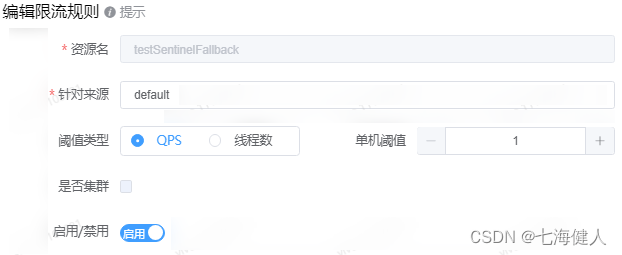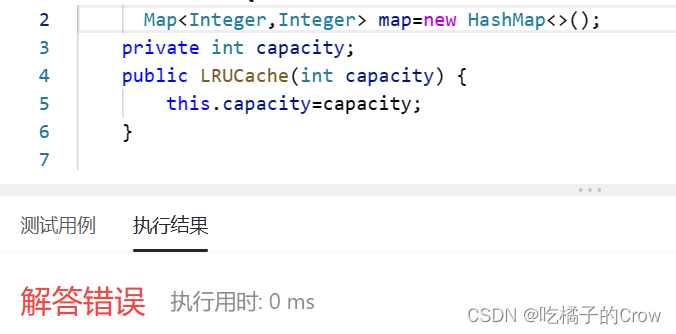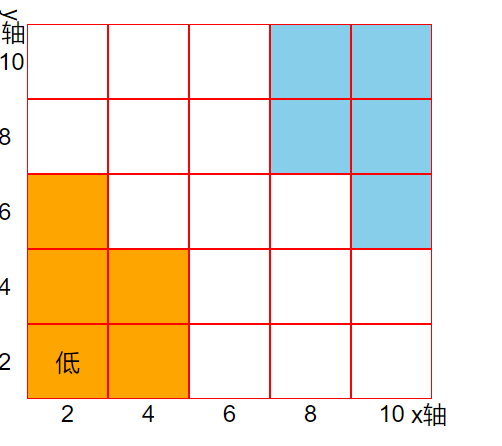SpringBoot第34讲:SpringBoot集成ShardingJDBC - 基于JPA的DB隔离多租户方案
本文是SpringBoot第34讲,主要介绍ShardingJDBC的分片算法和分片策略,并在此基础上通过SpringBoot集成ShardingJDBC的几种策略(标准分片策略,行表达式分片策略和hint分片策略)向你展示DB隔离的多租户方案
文章目录
- SpringBoot第34讲:SpringBoot集成ShardingJDBC - 基于JPA的DB隔离多租户方案
- 1、知识准备
- 1.1、逻辑表?绑定表?
- 1.2、分片算法?分片策略?
- 1、分片键
- 2、分片算法
- 3、分片策略
- 4、SQL Hint
- 1.3、ShardingJDBC 内部结构
- 1、初始化流程
- 2、使用约定
- 2、简单示例
- 2.1、准备DB和依赖配置
- 2.2、Entity
- 2.3、DAO
- 2.4、Service
- 2.5、Controller
- 2.6、简单测试
- 3、进一步理解
- 3.1、如果使用 standard 策略如何?
- 3.2、上述两种策略存在什么问题?
- 3.3、如何使用Hint强制路由方式?
- 4、示例源码
- 5、商品中心对ShardingJdbc的使用
- 6、白龙马对ShardingJdbc的使用
1、知识准备
主要理解ShardingJDBC表的基本术语,以及分片算法和分片策略等。
1.1、逻辑表?绑定表?
如下内容来自官网
- 逻辑表
水平拆分的数据库(表)的相同逻辑和数据结构表的总称。例:订单数据根据主键尾数拆分为10张表,分别是t_order_0到t_order_9,他们的逻辑表名为t_order。
- 真实表
在分片的数据库中真实存在的物理表。即上个示例中的t_order_0到t_order_9。
- 数据节点
数据分片的最小单元。由数据源名称和数据表组成,例:ds_0.t_order_0。
- 绑定表
指分片规则一致的主表和子表。例如:t_order表和t_order_item表,均按照order_id分片,则此两张表互为绑定表关系。绑定表之间的多表关联查询不会出现笛卡尔积关联,关联查询效率将大大提升。举例说明,如果SQL为:
SELECT i.* FROM t_order o JOIN t_order_item i ON o.order_id=i.order_id WHERE o.order_id in (10, 11);
在不配置绑定表关系时,假设分片键order_id将数值10路由至第0片,将数值11路由至第1片,那么路由后的SQL应该为4条,它们呈现为笛卡尔积:
SELECT i.* FROM t_order_0 o JOIN t_order_item_0 i ON o.order_id=i.order_id WHERE o.order_id in (10, 11);
SELECT i.* FROM t_order_0 o JOIN t_order_item_1 i ON o.order_id=i.order_id WHERE o.order_id in (10, 11);
SELECT i.* FROM t_order_1 o JOIN t_order_item_0 i ON o.order_id=i.order_id WHERE o.order_id in (10, 11);
SELECT i.* FROM t_order_1 o JOIN t_order_item_1 i ON o.order_id=i.order_id WHERE o.order_id in (10, 11);
在配置绑定表关系后,路由的SQL应该为2条:
SELECT i.* FROM t_order_0 o JOIN t_order_item_0 i ON o.order_id=i.order_id WHERE o.order_id in (10, 11);
SELECT i.* FROM t_order_1 o JOIN t_order_item_1 i ON o.order_id=i.order_id WHERE o.order_id in (10, 11);
其中 t_order 在FROM的最左侧,ShardingSphere将会以它作为整个绑定表的主表。 所有路由计算将会只使用主表的策略,那么t_order_item表的分片计算将会使用 t_order 的条件。故绑定表之间的分区键要完全相同。
- 广播表
指所有的分片数据源中都存在的表,表结构和表中的数据在每个数据库中均完全一致。适用于数据量不大且需要与海量数据的表进行关联查询的场景,例如:字典表。
1.2、分片算法?分片策略?
如下内容来自官网
1、分片键
用于分片的数据库字段,是将数据库(表)水平拆分的关键字段。例:将订单表中的订单主键的尾数取模分片,则订单主键为分片字段。 SQL中如果无分片字段,将执行全路由,性能较差。 除了对单分片字段的支持,ShardingSphere也支持根据多个字段进行分片。
2、分片算法
通过分片算法将数据分片,支持通过=、>=、<=、>、<、BETWEEN和IN分片。分片算法需要应用方开发者自行实现,可实现的灵活度非常高。
目前提供4种分片算法。由于分片算法和业务实现紧密相关,因此并未提供内置分片算法,而是通过分片策略将各种场景提炼出来,提供更高层级的抽象,并提供接口让应用开发者自行实现分片算法。
- 精确分片算法
对应 PreciseShardingAlgorithm,用于处理使用单一键作为分片键的 = 与 IN 进行分片的场景。需要配合 StandardShardingStrategy 使用。
- 范围分片算法
对应RangeShardingAlgorithm,用于处理使用单一键作为分片键的BETWEEN AND、>、<、>=、<= 进行分片的场景。需要配合StandardShardingStrategy使用。
- 复合分片算法
对应ComplexKeysShardingAlgorithm,用于处理使用多键作为分片键进行分片的场景,包含多个分片键的逻辑较复杂,需要应用开发者自行处理其中的复杂度。需要配合ComplexShardingStrategy使用。
- Hint分片算法
对应HintShardingAlgorithm,用于处理使用Hint行分片的场景。需要配合HintShardingStrategy使用。
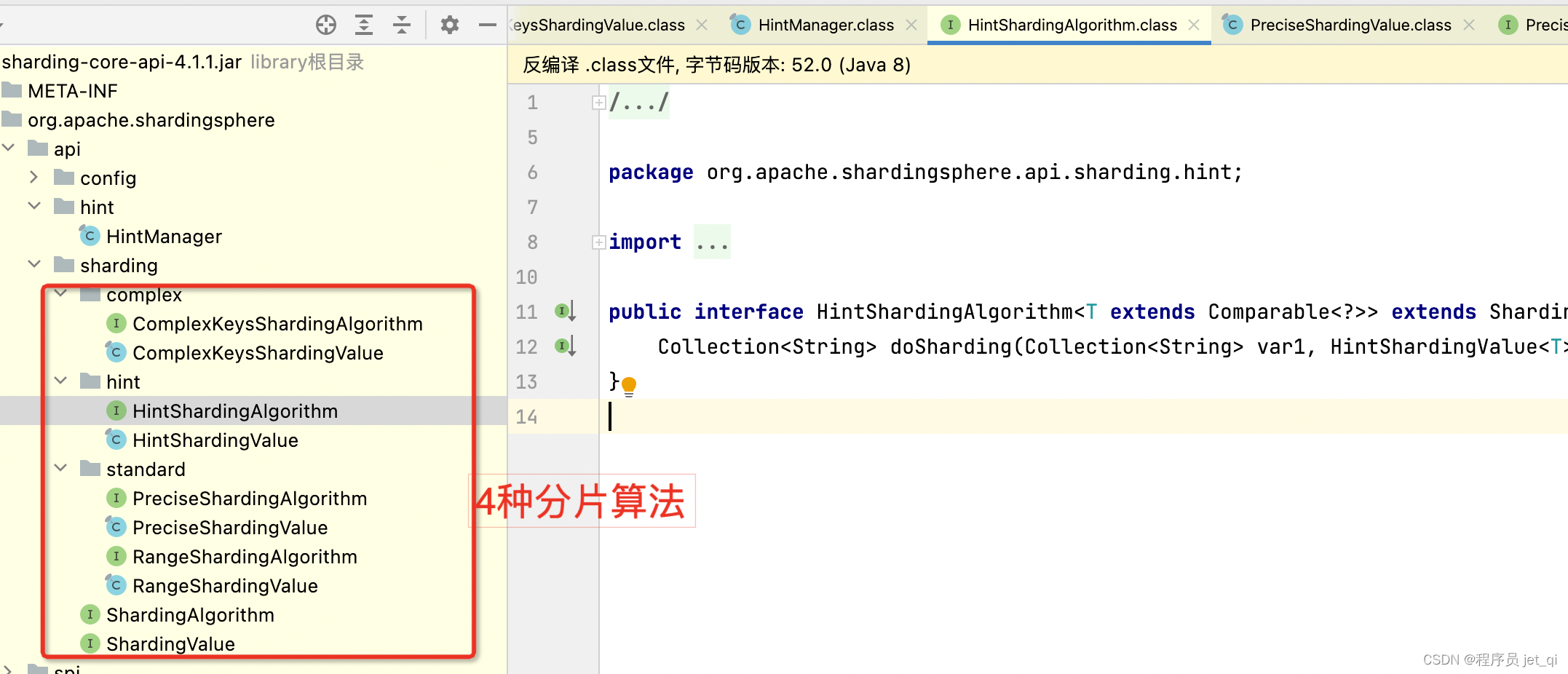
3、分片策略
包含分片键和分片算法,由于分片算法的独立性,将其独立抽离。真正可用于分片操作的是分片键 + 分片算法,也就是分片策略。目前提供5种分片策略。
- 标准分片策略
对应StandardShardingStrategy。提供对SQL语句中的=, >, <, >=, <=, IN和 BETWEEN AND 的分片操作支持。StandardShardingStrategy 只支持单分片键,提供PreciseShardingAlgorithm和RangeShardingAlgorithm两个分片算法。PreciseShardingAlgorithm是必选的,用于处理=和IN的分片。RangeShardingAlgorithm是可选的,用于处理BETWEEN AND, >, <, >=, <=分片,如果不配置RangeShardingAlgorithm,SQL中的BETWEEN AND将按照全库路由处理。
- 复合分片策略
对应ComplexShardingStrategy。复合分片策略。提供对SQL语句中的=, >, <, >=, <=, IN和BETWEEN AND的分片操作支持。ComplexShardingStrategy支持多分片键,由于多分片键之间的关系复杂,因此并未进行过多的封装,而是直接将分片键值组合以及分片操作符透传至分片算法,完全由应用开发者实现,提供最大的灵活度。
- 行表达式分片策略
对应InlineShardingStrategy。使用Groovy的表达式,提供对SQL语句中的=和IN的分片操作支持,只支持单分片键。对于简单的分片算法,可以通过简单的配置使用,从而避免繁琐的Java代码开发,如: t_user_$->{u_id % 8} 表示t_user表根据u_id模8,而分成8张表,表名称为t_user_0到t_user_7。
- Hint分片策略
对应 HintShardingStrategy。通过Hint指定分片值而非从SQL中提取分片值的方式进行分片的策略。
- 不分片策略
对应NoneShardingStrategy。不分片的策略。
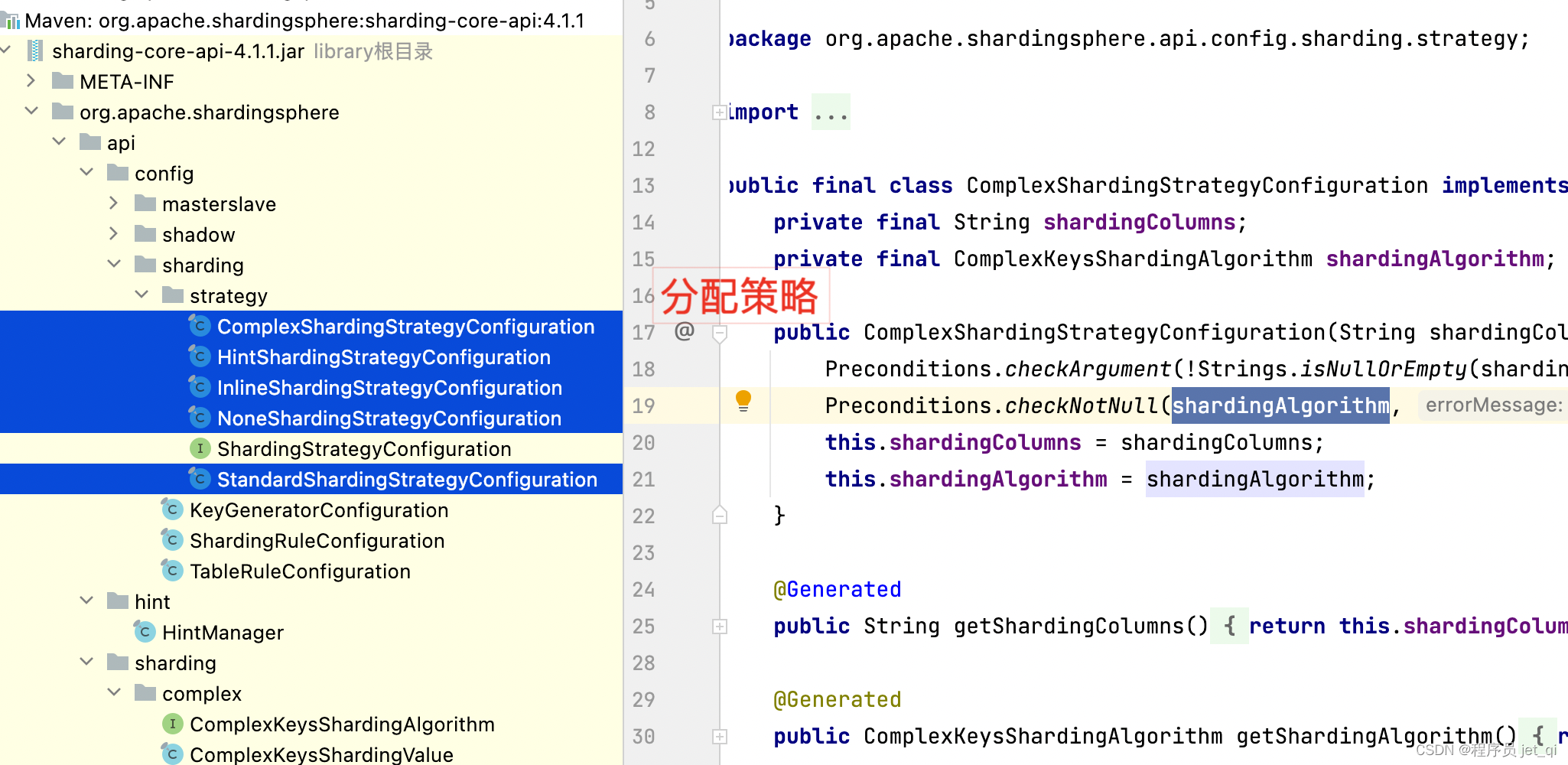
4、SQL Hint
对于分片字段非SQL决定,而由其他外置条件决定的场景,可使用SQL Hint灵活的注入分片字段。例:内部系统,按照员工登录主键分库,而数据库中并无此字段。SQL Hint支持通过Java API和SQL注释(待实现)两种方式使用。
1.3、ShardingJDBC 内部结构
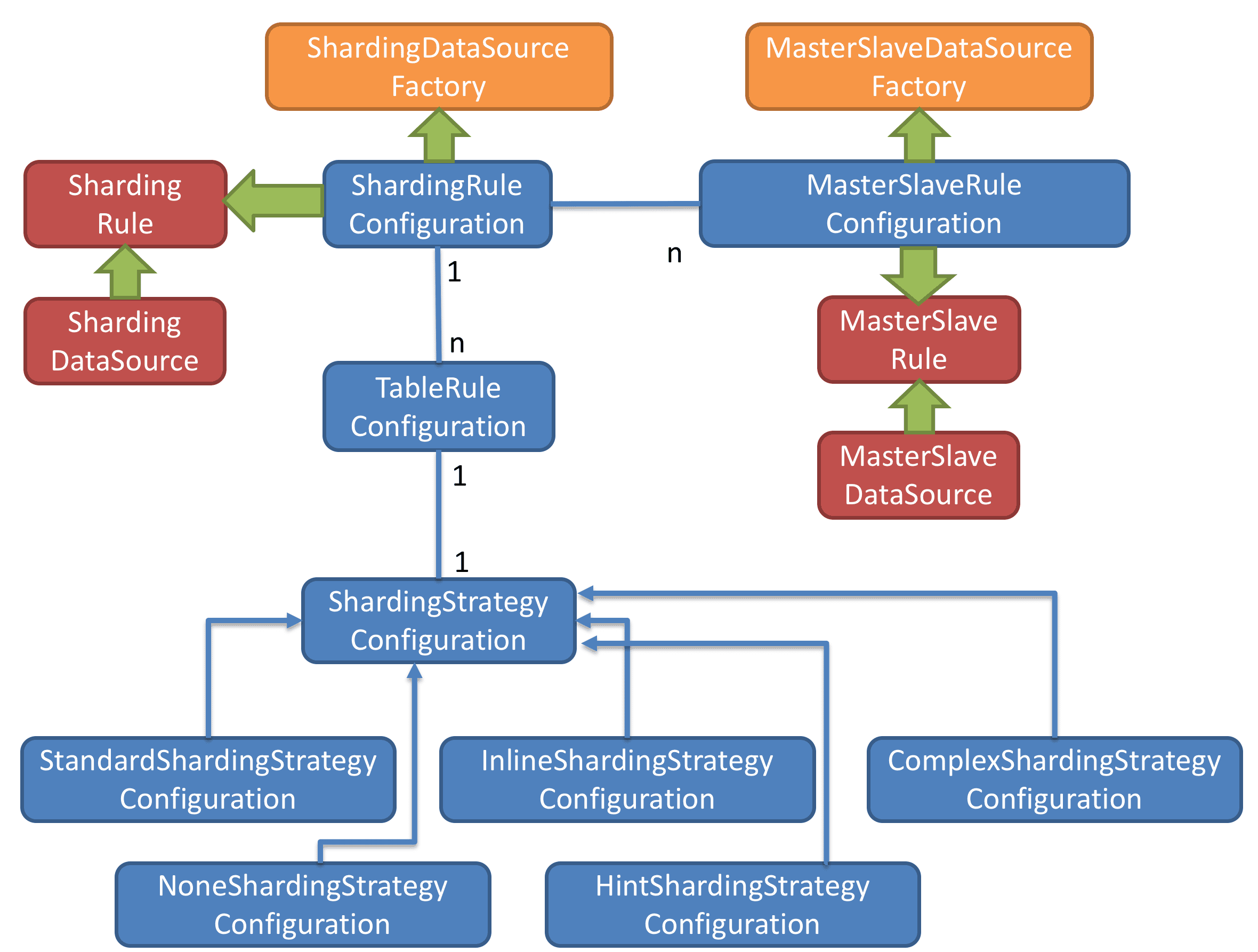
- 黄色部分
图中黄色部分表示的是Sharding-JDBC的入口API,采用工厂方法的形式提供。 目前有ShardingDataSourceFactory和MasterSlaveDataSourceFactory两个工厂类。ShardingDataSourceFactory用于创建分库分表或分库分表+读写分离的JDBC驱动,MasterSlaveDataSourceFactory用于创建独立使用读写分离的JDBC驱动。
- 蓝色部分
图中蓝色部分表示的是Sharding-JDBC的配置对象,提供灵活多变的配置方式。 ShardingRuleConfiguration 是分库分表配置的核心和入口,它可以包含多个 TableRuleConfiguration 和 MasterSlaveRuleConfiguration。每一组相同规则分片的表配置一个TableRuleConfiguration。如果需要分库分表和读写分离共同使用,每一个读写分离的逻辑库配置一个MasterSlaveRuleConfiguration。 每个TableRuleConfiguration对应一个ShardingStrategyConfiguration,它有5中实现类可供选择。
仅读写分离使用MasterSlaveRuleConfiguration即可。
- 红色部分
图中红色部分表示的是内部对象,由Sharding-JDBC内部使用,应用开发者无需关注。Sharding-JDBC通过 ShardingRuleConfiguration 和 MasterSlaveRuleConfiguration 生成真正供 ShardingDataSource 和 MasterSlaveDataSource 使用的规则对象。ShardingDataSource 和 MasterSlaveDataSource 实现了DataSource接口,是JDBC的完整实现方案。
1、初始化流程
- 配置Configuration对象。
- 通过Factory对象将Configuration对象转化为Rule对象。
- 通过Factory对象将Rule对象与DataSource对象装配。
- Sharding-JDBC使用DataSource对象进行分库。
2、使用约定
在org.apache.shardingsphere.api 和 org.apache.shardingsphere.shardingjdbc.api 包中的类是面向用户的API,每次修改都会在release notes 中明确声明。 其他包中的类属于内部实现,可能随时进行调整,请勿直接使用。
2、简单示例
这里主要介绍 SpringBoot 集成基于 ShardingJDBC 的按字段分库,两种策略(标准分片策略 和 行表达式分片策略),主要承接之前的相关文章在JPA方式的基础上实现的。
2.1、准备DB和依赖配置
创建MySQL的schema db_user_tenant_a 和 db_user_tenant_b, 导入SQL 文件如下
db_user_tenant_a
DROP TABLE IF EXISTS `tb_role`;
/*!40101 SET @saved_cs_client = @@character_set_client */;
/*!50503 SET character_set_client = utf8mb4 */;
CREATE TABLE `tb_role` (
`id` bigint NOT NULL,
`name` varchar(255) NOT NULL,
`role_key` varchar(255) NOT NULL,
`description` varchar(255) DEFAULT NULL,
`create_time` datetime DEFAULT NULL,
`update_time` datetime DEFAULT NULL,
`tenant` varchar(45) DEFAULT NULL,
PRIMARY KEY (`id`)
) ENGINE=InnoDB DEFAULT CHARSET=utf8mb3;
/*!40101 SET character_set_client = @saved_cs_client */;
--
-- Dumping data for table `tb_role`
--
LOCK TABLES `tb_role` WRITE;
/*!40000 ALTER TABLE `tb_role` DISABLE KEYS */;
/*!40000 ALTER TABLE `tb_role` ENABLE KEYS */;
UNLOCK TABLES;
--
-- Table structure for table `tb_user`
--
DROP TABLE IF EXISTS `tb_user`;
/*!40101 SET @saved_cs_client = @@character_set_client */;
/*!50503 SET character_set_client = utf8mb4 */;
CREATE TABLE `tb_user` (
`id` bigint NOT NULL,
`user_name` varchar(45) NOT NULL,
`password` varchar(45) NOT NULL,
`email` varchar(45) DEFAULT NULL,
`phone_number` int DEFAULT NULL,
`description` varchar(255) DEFAULT NULL,
`create_time` datetime DEFAULT NULL,
`update_time` datetime DEFAULT NULL,
`tenant` varchar(45) DEFAULT NULL,
PRIMARY KEY (`id`)
) ENGINE=InnoDB DEFAULT CHARSET=utf8mb3;
/*!40101 SET character_set_client = @saved_cs_client */;
--
-- Dumping data for table `tb_user`
--
LOCK TABLES `tb_user` WRITE;
/*!40000 ALTER TABLE `tb_user` DISABLE KEYS */;
/*!40000 ALTER TABLE `tb_user` ENABLE KEYS */;
UNLOCK TABLES;
--
-- Table structure for table `tb_user_role`
--
DROP TABLE IF EXISTS `tb_user_role`;
/*!40101 SET @saved_cs_client = @@character_set_client */;
/*!50503 SET character_set_client = utf8mb4 */;
CREATE TABLE `tb_user_role` (
`id` bigint NOT NULL,
`user_id` bigint NOT NULL,
`role_id` bigint NOT NULL,
`tenant` varchar(45) DEFAULT NULL,
PRIMARY KEY (`id`)
) ENGINE=InnoDB DEFAULT CHARSET=utf8mb3;
/*!40101 SET character_set_client = @saved_cs_client */;
--
-- Dumping data for table `tb_user_role`
--
LOCK TABLES `tb_user_role` WRITE;
/*!40000 ALTER TABLE `tb_user_role` DISABLE KEYS */;
/*!40000 ALTER TABLE `tb_user_role` ENABLE KEYS */;
UNLOCK TABLES;
db_user_tenant_b
DROP TABLE IF EXISTS `tb_role`;
/*!40101 SET @saved_cs_client = @@character_set_client */;
/*!50503 SET character_set_client = utf8mb4 */;
CREATE TABLE `tb_role` (
`id` bigint NOT NULL,
`name` varchar(255) NOT NULL,
`role_key` varchar(255) NOT NULL,
`description` varchar(255) DEFAULT NULL,
`create_time` datetime DEFAULT NULL,
`update_time` datetime DEFAULT NULL,
`tenant` varchar(45) DEFAULT NULL,
PRIMARY KEY (`id`)
) ENGINE=InnoDB DEFAULT CHARSET=utf8mb3;
/*!40101 SET character_set_client = @saved_cs_client */;
--
-- Dumping data for table `tb_role`
--
LOCK TABLES `tb_role` WRITE;
/*!40000 ALTER TABLE `tb_role` DISABLE KEYS */;
/*!40000 ALTER TABLE `tb_role` ENABLE KEYS */;
UNLOCK TABLES;
--
-- Table structure for table `tb_user`
--
DROP TABLE IF EXISTS `tb_user`;
/*!40101 SET @saved_cs_client = @@character_set_client */;
/*!50503 SET character_set_client = utf8mb4 */;
CREATE TABLE `tb_user` (
`id` bigint NOT NULL,
`user_name` varchar(45) NOT NULL,
`password` varchar(45) NOT NULL,
`email` varchar(45) DEFAULT NULL,
`phone_number` int DEFAULT NULL,
`description` varchar(255) DEFAULT NULL,
`create_time` datetime DEFAULT NULL,
`update_time` datetime DEFAULT NULL,
`tenant` varchar(45) DEFAULT NULL,
PRIMARY KEY (`id`)
) ENGINE=InnoDB DEFAULT CHARSET=utf8mb3;
/*!40101 SET character_set_client = @saved_cs_client */;
--
-- Dumping data for table `tb_user`
--
LOCK TABLES `tb_user` WRITE;
/*!40000 ALTER TABLE `tb_user` DISABLE KEYS */;
/*!40000 ALTER TABLE `tb_user` ENABLE KEYS */;
UNLOCK TABLES;
--
-- Table structure for table `tb_user_role`
--
DROP TABLE IF EXISTS `tb_user_role`;
/*!40101 SET @saved_cs_client = @@character_set_client */;
/*!50503 SET character_set_client = utf8mb4 */;
CREATE TABLE `tb_user_role` (
`id` bigint NOT NULL,
`user_id` bigint NOT NULL,
`role_id` bigint NOT NULL,
`tenant` varchar(45) DEFAULT NULL,
PRIMARY KEY (`id`)
) ENGINE=InnoDB DEFAULT CHARSET=utf8mb3;
/*!40101 SET character_set_client = @saved_cs_client */;
--
-- Dumping data for table `tb_user_role`
--
LOCK TABLES `tb_user_role` WRITE;
/*!40000 ALTER TABLE `tb_user_role` DISABLE KEYS */;
/*!40000 ALTER TABLE `tb_user_role` ENABLE KEYS */;
UNLOCK TABLES;
引入maven依赖, 包含mysql驱动,JPA包, 以及sharding-jdbc的依赖。
<dependency>
<groupId>mysql</groupId>
<artifactId>mysql-connector-java</artifactId>
<version>8.0.28</version>
</dependency>
<dependency>
<groupId>com.github.wenhao</groupId>
<artifactId>jpa-spec</artifactId>
<version>3.1.0</version>
</dependency>
<dependency>
<groupId>org.springframework.boot</groupId>
<artifactId>spring-boot-starter-data-jpa</artifactId>
</dependency>
<dependency>
<groupId>org.apache.shardingsphere</groupId>
<artifactId>sharding-jdbc-spring-boot-starter</artifactId>
<version>4.1.1</version>
</dependency>
增加yml配置
spring:
shardingsphere:
datasource:
names: tenant-a,tenant-b
tenant-a:
type: com.zaxxer.hikari.HikariDataSource
driver-class-name: com.mysql.cj.jdbc.Driver
jdbc-url: jdbc:mysql://localhost:3306/db_user_tenant_a?allowPublicKeyRetrieval=true&useSSL=false&autoReconnect=true&characterEncoding=utf8
username: root
password: qwj930828
tenant-b:
type: com.zaxxer.hikari.HikariDataSource
driver-class-name: com.mysql.cj.jdbc.Driver
jdbc-url: jdbc:mysql://localhost:3306/db_user_tenant_b?allowPublicKeyRetrieval=true&useSSL=false&autoReconnect=true&characterEncoding=utf8
username: root
password: qwj930828
sharding:
default-database-strategy:
# way 1: standard strategy
# standard:
# precise-algorithm-class-name: springboot.shardingjdbc.jpa.tenant.db.config.MyPreciseShardingDBAlgorithm
# sharding-column: tenant
# way 2: inline strategy
inline:
sharding-column: tenant
algorithm-expression: tenant-$->{tenant}
tables:
tb_user:
actual-data-nodes: tenant-${['a','b']}.tb_user
key-generator:
column: id
type: SNOWFLAKE
props:
worker:
id: 123
tb_role:
actual-data-nodes: tenant-${['a','b']}.tb_role
key-generator:
column: id
type: SNOWFLAKE
props:
worker:
id: 123
tb_user_role:
actual-data-nodes: tenant-${['a','b']}.tb_user_role
key-generator:
column: id
type: SNOWFLAKE
props:
worker:
id: 123
binding-tables: tb_user,tb_role,tb_user_role
props:
sql:
show: true
jpa:
open-in-view: false
generate-ddl: false
show-sql: false
properties:
hibernate:
dialect: org.hibernate.dialect.MySQLDialect
format_sql: true
use-new-id-generator-mappings: false
2.2、Entity
user entity
package springboot.shardingjdbc.jpa.tenant.db.entity;
import java.time.LocalDateTime;
import java.util.Set;
import javax.persistence.CascadeType;
import javax.persistence.Column;
import javax.persistence.Entity;
import javax.persistence.FetchType;
import javax.persistence.GeneratedValue;
import javax.persistence.GenerationType;
import javax.persistence.Id;
import javax.persistence.JoinColumn;
import javax.persistence.JoinTable;
import javax.persistence.ManyToMany;
import javax.persistence.Table;
import lombok.Getter;
import lombok.Setter;
import lombok.ToString;
/**
* @author qiwenjie
*/
@Getter
@Setter
@ToString
@Entity
@Table(name = "tb_user")
public class User implements BaseEntity {
/**
* user id.
*/
@Id
@GeneratedValue(strategy = GenerationType.IDENTITY)
@Column(name = "id", nullable = false)
private Long id;
/**
* username.
*/
private String userName;
/**
* user pwd.
*/
private String password;
/**
* email.
*/
private String email;
/**
* phoneNumber.
*/
private long phoneNumber;
/**
* description.
*/
private String description;
/**
* create date time.
*/
private LocalDateTime createTime;
/**
* update date time.
*/
private LocalDateTime updateTime;
/**
* tenant.
*/
private String tenant;
/**
* join to role table.
*/
@ManyToMany(cascade = {CascadeType.REFRESH}, fetch = FetchType.EAGER)
@JoinTable(name = "tb_user_role", joinColumns = {
@JoinColumn(name = "user_id")}, inverseJoinColumns = {@JoinColumn(name = "role_id")})
private Set<Role> roles;
}
role entity
package springboot.shardingjdbc.jpa.tenant.db.entity;
import lombok.Getter;
import lombok.Setter;
import lombok.ToString;
import javax.persistence.*;
import java.time.LocalDateTime;
/**
* @author qiwenjie
*/
@Getter
@Setter
@ToString
@Entity
@Table(name = "tb_role")
public class Role implements BaseEntity {
/**
* role id.
*/
@Id
@GeneratedValue(strategy = GenerationType.IDENTITY)
@Column(name = "id", nullable = false)
private Long id;
/**
* role name.
*/
private String name;
/**
* role key.
*/
private String roleKey;
/**
* description.
*/
private String description;
/**
* create date time.
*/
private LocalDateTime createTime;
/**
* update date time.
*/
private LocalDateTime updateTime;
/**
* tenant.
*/
private String tenant;
}
2.3、DAO
user dao
package springboot.shardingjdbc.jpa.tenant.db.dao;
import org.springframework.stereotype.Repository;
import springboot.shardingjdbc.jpa.tenant.db.entity.User;
/**
* @author qiwenjie
*/
@Repository
public interface IUserDao extends IBaseDao<User, Long> {
}
role dao
package springboot.shardingjdbc.jpa.tenant.db.dao;
import org.springframework.stereotype.Repository;
import springboot.shardingjdbc.jpa.tenant.db.entity.Role;
/**
* @author qiwenjie
*/
@Repository
public interface IRoleDao extends IBaseDao<Role, Long> {
}
2.4、Service
user service 接口
package springboot.shardingjdbc.jpa.tenant.db.service;
import org.springframework.data.domain.Page;
import org.springframework.data.domain.PageRequest;
import springboot.shardingjdbc.jpa.tenant.db.entity.User;
import springboot.shardingjdbc.jpa.tenant.db.entity.query.UserQueryBean;
/**
* @author qiwenjie
*/
public interface IUserService extends IBaseService<User, Long> {
/**
* find by page.
*
* @param userQueryBean query
* @param pageRequest pageRequest
* @return page
*/
Page<User> findPage(UserQueryBean userQueryBean, PageRequest pageRequest);
}
user service 实现类
package springboot.shardingjdbc.jpa.tenant.db.service.impl;
import com.github.wenhao.jpa.Specifications;
import org.apache.commons.lang3.StringUtils;
import org.springframework.data.domain.Page;
import org.springframework.data.domain.PageRequest;
import org.springframework.data.jpa.domain.Specification;
import org.springframework.stereotype.Service;
import springboot.shardingjdbc.jpa.tenant.db.dao.IBaseDao;
import springboot.shardingjdbc.jpa.tenant.db.dao.IUserDao;
import springboot.shardingjdbc.jpa.tenant.db.entity.User;
import springboot.shardingjdbc.jpa.tenant.db.entity.query.UserQueryBean;
import springboot.shardingjdbc.jpa.tenant.db.service.IUserService;
@Service
public class UserDoServiceImpl extends BaseDoServiceImpl<User, Long> implements IUserService {
/**
* userDao.
*/
private final IUserDao userDao;
/**
* init.
*
* @param userDao2 user dao
*/
public UserDoServiceImpl(final IUserDao userDao2) {
this.userDao = userDao2;
}
/**
* @return base dao
*/
@Override
public IBaseDao<User, Long> getBaseDao() {
return this.userDao;
}
/**
* find by page.
*
* @param queryBean query
* @param pageRequest pageRequest
* @return page
*/
@Override
public Page<User> findPage(UserQueryBean queryBean, PageRequest pageRequest) {
Specification<User> specification = Specifications.<User>and()
.eq(StringUtils.isNotEmpty(queryBean.getTenant()), "tenant", queryBean.getTenant())
.like(StringUtils.isNotEmpty(queryBean.getName()), "user_name", queryBean.getName())
.like(StringUtils.isNotEmpty(queryBean.getDescription()), "description",
queryBean.getDescription())
.build();
return this.getBaseDao().findAll(specification, pageRequest);
}
}
role service 接口
package springboot.shardingjdbc.jpa.tenant.db.service;
import org.springframework.data.domain.Page;
import org.springframework.data.domain.PageRequest;
import springboot.shardingjdbc.jpa.tenant.db.entity.Role;
import springboot.shardingjdbc.jpa.tenant.db.entity.query.RoleQueryBean;
public interface IRoleService extends IBaseService<Role, Long> {
/**
* find page by query.
*
* @param roleQueryBean query
* @param pageRequest pageRequest
* @return page
*/
Page<Role> findPage(RoleQueryBean roleQueryBean, PageRequest pageRequest);
}
role service 实现类
package springboot.shardingjdbc.jpa.tenant.db.service.impl;
import com.github.wenhao.jpa.Specifications;
import org.apache.commons.lang3.StringUtils;
import org.springframework.data.domain.Page;
import org.springframework.data.domain.PageRequest;
import org.springframework.data.jpa.domain.Specification;
import org.springframework.stereotype.Service;
import springboot.shardingjdbc.jpa.tenant.db.dao.IBaseDao;
import springboot.shardingjdbc.jpa.tenant.db.dao.IRoleDao;
import springboot.shardingjdbc.jpa.tenant.db.entity.Role;
import springboot.shardingjdbc.jpa.tenant.db.entity.query.RoleQueryBean;
import springboot.shardingjdbc.jpa.tenant.db.service.IRoleService;
@Service
public class RoleDoServiceImpl extends BaseDoServiceImpl<Role, Long> implements IRoleService {
/**
* roleDao.
*/
private final IRoleDao roleDao;
/**
* init.
*
* @param roleDao2 role dao
*/
public RoleDoServiceImpl(final IRoleDao roleDao2) {
this.roleDao = roleDao2;
}
/**
* @return base dao
*/
@Override
public IBaseDao<Role, Long> getBaseDao() {
return this.roleDao;
}
/**
* find page by query.
*
* @param roleQueryBean query
* @param pageRequest pageRequest
* @return page
*/
@Override
public Page<Role> findPage(RoleQueryBean roleQueryBean, PageRequest pageRequest) {
Specification<Role> specification = Specifications.<Role>and()
.eq(StringUtils.isNotEmpty(roleQueryBean.getTenant()), "tenant", roleQueryBean.getTenant())
.like(StringUtils.isNotEmpty(roleQueryBean.getName()), "name",
roleQueryBean.getName())
.like(StringUtils.isNotEmpty(roleQueryBean.getDescription()), "description",
roleQueryBean.getDescription())
.build();
return this.roleDao.findAll(specification, pageRequest);
}
}
2.5、Controller
user controller
package springboot.shardingjdbc.jpa.tenant.db.controller;
import java.time.LocalDateTime;
import io.swagger.annotations.ApiOperation;
import org.springframework.beans.factory.annotation.Autowired;
import org.springframework.data.domain.Page;
import org.springframework.data.domain.PageRequest;
import org.springframework.web.bind.annotation.GetMapping;
import org.springframework.web.bind.annotation.PathVariable;
import org.springframework.web.bind.annotation.PostMapping;
import org.springframework.web.bind.annotation.RequestMapping;
import org.springframework.web.bind.annotation.RequestParam;
import org.springframework.web.bind.annotation.RestController;
import springboot.shardingjdbc.jpa.tenant.db.entity.User;
import springboot.shardingjdbc.jpa.tenant.db.entity.query.UserQueryBean;
import springboot.shardingjdbc.jpa.tenant.db.entity.response.ResponseResult;
import springboot.shardingjdbc.jpa.tenant.db.service.IUserService;
/**
* @author qiwenjie
*/
@RestController
@RequestMapping("/user")
public class UserController {
@Autowired
private IUserService userService;
/**
* @param user user param
* @return user
*/
@ApiOperation("Add/Edit User")
@PostMapping("add")
public ResponseResult<User> add(User user) {
if (user.getId()==null || !userService.exists(user.getId())) {
user.setCreateTime(LocalDateTime.now());
user.setUpdateTime(LocalDateTime.now());
userService.save(user);
} else {
user.setUpdateTime(LocalDateTime.now());
userService.update(user);
}
return ResponseResult.success(userService.find(user.getId()));
}
/**
* @return user list
*/
@ApiOperation("Query User One")
@GetMapping("edit/{userId}")
public ResponseResult<User> edit(@PathVariable("userId") Long userId) {
return ResponseResult.success(userService.find(userId));
}
/**
* @return user list
*/
@ApiOperation("Query User Page")
@GetMapping("list")
public ResponseResult<Page<User>> list(@RequestParam int pageSize, @RequestParam int pageNumber, String tenant) {
return ResponseResult.success(userService.findPage(UserQueryBean.builder().tenant(tenant).build(), PageRequest.of(pageNumber, pageSize)));
}
}
2.6、简单测试
访问页面:
http://localhost:8080/doc.html
插入数据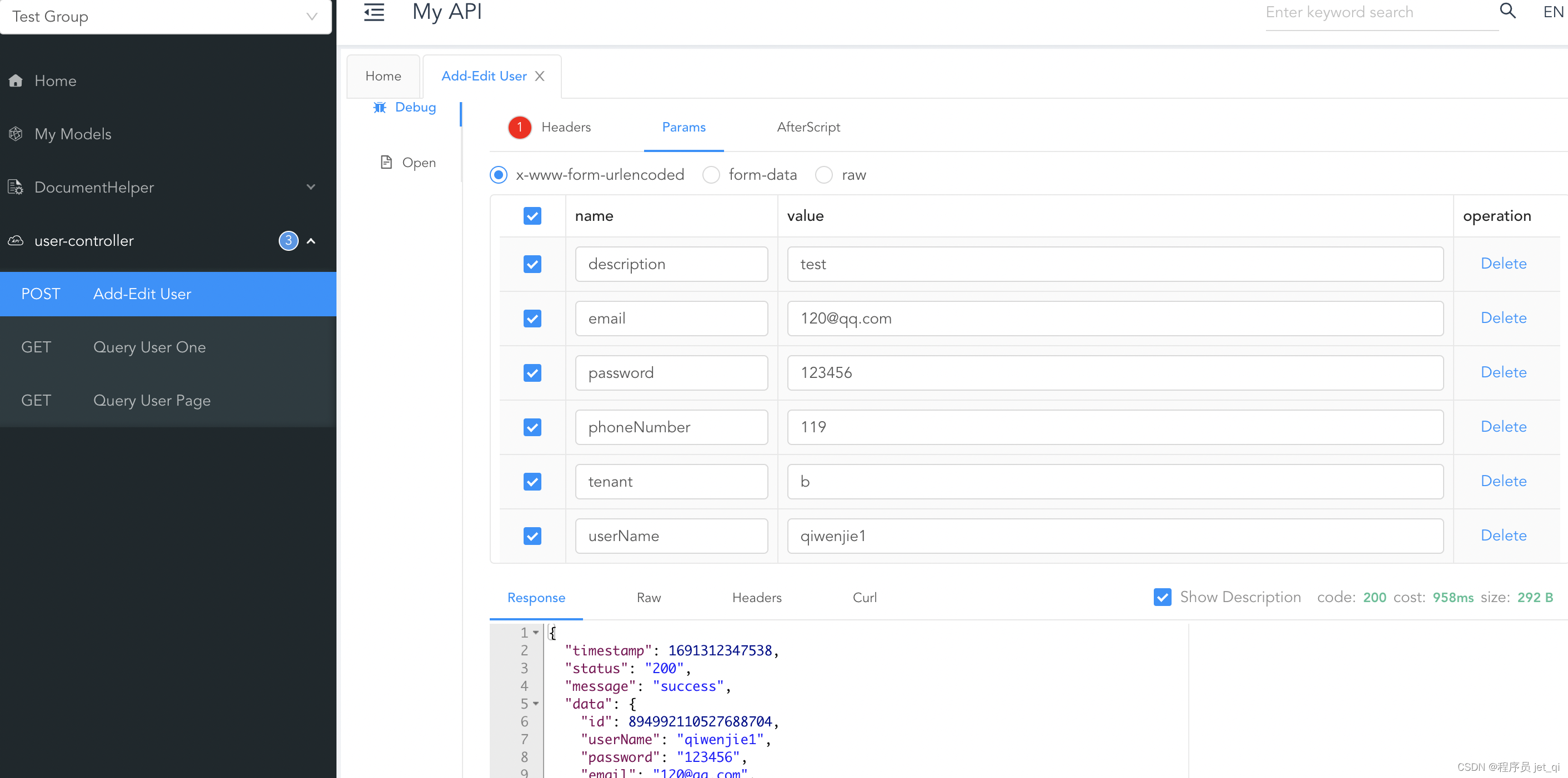
DB 中对应schema中的数据

查询数据
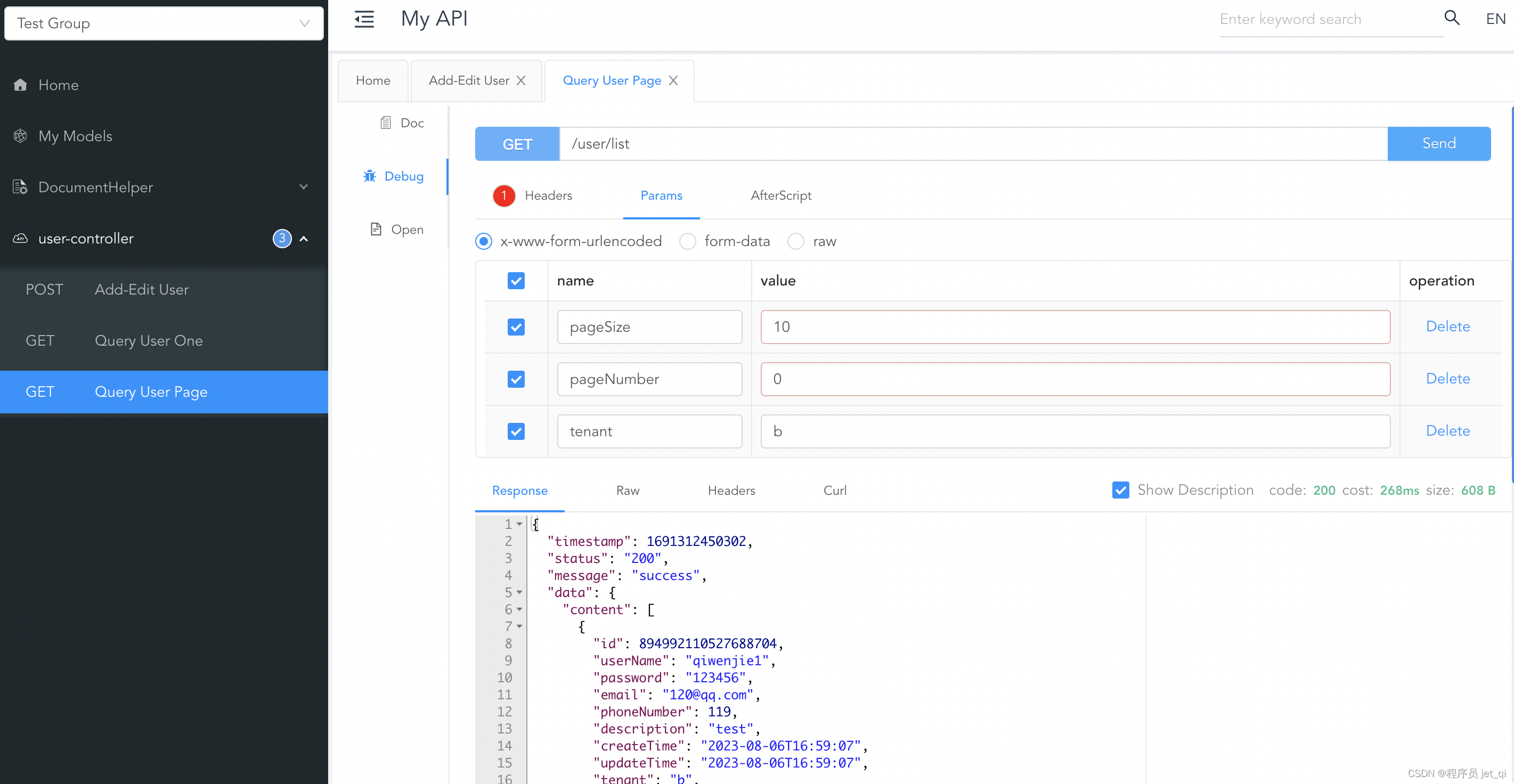
相关查询console打印出的日志:
2023-08-06 16:59:07.348 INFO 7427 --- [nio-8080-exec-5] ShardingSphere-SQL : Logic SQL: insert into tb_user (create_time, description, email, password, phone_number, tenant, update_time, user_name) values (?, ?, ?, ?, ?, ?, ?, ?)
2023-08-06 16:59:07.348 INFO 7427 --- [nio-8080-exec-5] ShardingSphere-SQL : SQLStatement: InsertStatementContext(super=CommonSQLStatementContext(sqlStatement=org.apache.shardingsphere.sql.parser.sql.statement.dml.InsertStatement@24413032, tablesContext=org.apache.shardingsphere.sql.parser.binder.segment.table.TablesContext@e4d38de), tablesContext=org.apache.shardingsphere.sql.parser.binder.segment.table.TablesContext@e4d38de, columnNames=[create_time, description, email, password, phone_number, tenant, update_time, user_name], insertValueContexts=[InsertValueContext(parametersCount=8, valueExpressions=[ParameterMarkerExpressionSegment(startIndex=118, stopIndex=118, parameterMarkerIndex=0), ParameterMarkerExpressionSegment(startIndex=121, stopIndex=121, parameterMarkerIndex=1), ParameterMarkerExpressionSegment(startIndex=124, stopIndex=124, parameterMarkerIndex=2), ParameterMarkerExpressionSegment(startIndex=127, stopIndex=127, parameterMarkerIndex=3), ParameterMarkerExpressionSegment(startIndex=130, stopIndex=130, parameterMarkerIndex=4), ParameterMarkerExpressionSegment(startIndex=133, stopIndex=133, parameterMarkerIndex=5), ParameterMarkerExpressionSegment(startIndex=136, stopIndex=136, parameterMarkerIndex=6), ParameterMarkerExpressionSegment(startIndex=139, stopIndex=139, parameterMarkerIndex=7), DerivedParameterMarkerExpressionSegment(super=ParameterMarkerExpressionSegment(startIndex=0, stopIndex=0, parameterMarkerIndex=8))], parameters=[2023-08-06 16:59:06.641931, test, 120@qq.com, 123456, 119, b, 2023-08-06 16:59:06.641998, qiwenjie1])], generatedKeyContext=Optional[GeneratedKeyContext(columnName=id, generated=true, generatedValues=[894992110527688704])])
2023-08-06 16:59:07.349 INFO 7427 --- [nio-8080-exec-5] ShardingSphere-SQL : Actual SQL: tenant-b ::: insert into tb_user (create_time, description, email, password, phone_number, tenant, update_time, user_name, id) values (?, ?, ?, ?, ?, ?, ?, ?, ?) ::: [2023-08-06 16:59:06.641931, test, 120@qq.com, 123456, 119, b, 2023-08-06 16:59:06.641998, qiwenjie1, 894992110527688704]
2023-08-06 16:59:07.489 INFO 7427 --- [nio-8080-exec-5] ShardingSphere-SQL : Logic SQL: select user0_.id as id1_1_0_, user0_.create_time as create_t2_1_0_, user0_.description as descript3_1_0_, user0_.email as email4_1_0_, user0_.password as password5_1_0_, user0_.phone_number as phone_nu6_1_0_, user0_.tenant as tenant7_1_0_, user0_.update_time as update_t8_1_0_, user0_.user_name as user_nam9_1_0_, roles1_.user_id as user_id1_2_1_, role2_.id as role_id2_2_1_, role2_.id as id1_0_2_, role2_.create_time as create_t2_0_2_, role2_.description as descript3_0_2_, role2_.name as name4_0_2_, role2_.role_key as role_key5_0_2_, role2_.tenant as tenant6_0_2_, role2_.update_time as update_t7_0_2_ from tb_user user0_ left outer join tb_user_role roles1_ on user0_.id=roles1_.user_id left outer join tb_role role2_ on roles1_.role_id=role2_.id where user0_.id=?
2023-08-06 16:59:07.489 INFO 7427 --- [nio-8080-exec-5] ShardingSphere-SQL : SQLStatement: SelectStatementContext(super=CommonSQLStatementContext(sqlStatement=org.apache.shardingsphere.sql.parser.sql.statement.dml.SelectStatement@3b2cb03, tablesContext=org.apache.shardingsphere.sql.parser.binder.segment.table.TablesContext@537648d), tablesContext=org.apache.shardingsphere.sql.parser.binder.segment.table.TablesContext@537648d, projectionsContext=ProjectionsContext(startIndex=7, stopIndex=603, distinctRow=false, projections=[ColumnProjection(owner=user0_, name=id, alias=Optional[id1_1_0_]), ColumnProjection(owner=user0_, name=create_time, alias=Optional[create_t2_1_0_]), ColumnProjection(owner=user0_, name=description, alias=Optional[descript3_1_0_]), ColumnProjection(owner=user0_, name=email, alias=Optional[email4_1_0_]), ColumnProjection(owner=user0_, name=password, alias=Optional[password5_1_0_]), ColumnProjection(owner=user0_, name=phone_number, alias=Optional[phone_nu6_1_0_]), ColumnProjection(owner=user0_, name=tenant, alias=Optional[tenant7_1_0_]), ColumnProjection(owner=user0_, name=update_time, alias=Optional[update_t8_1_0_]), ColumnProjection(owner=user0_, name=user_name, alias=Optional[user_nam9_1_0_]), ColumnProjection(owner=roles1_, name=user_id, alias=Optional[user_id1_2_1_]), ColumnProjection(owner=role2_, name=id, alias=Optional[role_id2_2_1_]), ColumnProjection(owner=role2_, name=id, alias=Optional[id1_0_2_]), ColumnProjection(owner=role2_, name=create_time, alias=Optional[create_t2_0_2_]), ColumnProjection(owner=role2_, name=description, alias=Optional[descript3_0_2_]), ColumnProjection(owner=role2_, name=name, alias=Optional[name4_0_2_]), ColumnProjection(owner=role2_, name=role_key, alias=Optional[role_key5_0_2_]), ColumnProjection(owner=role2_, name=tenant, alias=Optional[tenant6_0_2_]), ColumnProjection(owner=role2_, name=update_time, alias=Optional[update_t7_0_2_])]), groupByContext=org.apache.shardingsphere.sql.parser.binder.segment.select.groupby.GroupByContext@397cae83, orderByContext=org.apache.shardingsphere.sql.parser.binder.segment.select.orderby.OrderByContext@8f1dae0, paginationContext=org.apache.shardingsphere.sql.parser.binder.segment.select.pagination.PaginationContext@1d0ef22e, containsSubquery=false)
2023-08-06 16:59:07.489 INFO 7427 --- [nio-8080-exec-5] ShardingSphere-SQL : Actual SQL: tenant-b ::: select user0_.id as id1_1_0_, user0_.create_time as create_t2_1_0_, user0_.description as descript3_1_0_, user0_.email as email4_1_0_, user0_.password as password5_1_0_, user0_.phone_number as phone_nu6_1_0_, user0_.tenant as tenant7_1_0_, user0_.update_time as update_t8_1_0_, user0_.user_name as user_nam9_1_0_, roles1_.user_id as user_id1_2_1_, role2_.id as role_id2_2_1_, role2_.id as id1_0_2_, role2_.create_time as create_t2_0_2_, role2_.description as descript3_0_2_, role2_.name as name4_0_2_, role2_.role_key as role_key5_0_2_, role2_.tenant as tenant6_0_2_, role2_.update_time as update_t7_0_2_ from tb_user user0_ left outer join tb_user_role roles1_ on user0_.id=roles1_.user_id left outer join tb_role role2_ on roles1_.role_id=role2_.id where user0_.id=? ::: [894992110527688704]
2023-08-06 16:59:07.489 INFO 7427 --- [nio-8080-exec-5] ShardingSphere-SQL : Actual SQL: tenant-a ::: select user0_.id as id1_1_0_, user0_.create_time as create_t2_1_0_, user0_.description as descript3_1_0_, user0_.email as email4_1_0_, user0_.password as password5_1_0_, user0_.phone_number as phone_nu6_1_0_, user0_.tenant as tenant7_1_0_, user0_.update_time as update_t8_1_0_, user0_.user_name as user_nam9_1_0_, roles1_.user_id as user_id1_2_1_, role2_.id as role_id2_2_1_, role2_.id as id1_0_2_, role2_.create_time as create_t2_0_2_, role2_.description as descript3_0_2_, role2_.name as name4_0_2_, role2_.role_key as role_key5_0_2_, role2_.tenant as tenant6_0_2_, role2_.update_time as update_t7_0_2_ from tb_user user0_ left outer join tb_user_role roles1_ on user0_.id=roles1_.user_id left outer join tb_role role2_ on roles1_.role_id=role2_.id where user0_.id=? ::: [894992110527688704]
2023-08-06 17:00:50.273 INFO 7427 --- [nio-8080-exec-4] ShardingSphere-SQL : Logic SQL: select user0_.id as id1_1_, user0_.create_time as create_t2_1_, user0_.description as descript3_1_, user0_.email as email4_1_, user0_.password as password5_1_, user0_.phone_number as phone_nu6_1_, user0_.tenant as tenant7_1_, user0_.update_time as update_t8_1_, user0_.user_name as user_nam9_1_ from tb_user user0_ where user0_.tenant=? limit ?
2023-08-06 17:00:50.273 INFO 7427 --- [nio-8080-exec-4] ShardingSphere-SQL : SQLStatement: SelectStatementContext(super=CommonSQLStatementContext(sqlStatement=org.apache.shardingsphere.sql.parser.sql.statement.dml.SelectStatement@1c4bf821, tablesContext=org.apache.shardingsphere.sql.parser.binder.segment.table.TablesContext@43004ed8), tablesContext=org.apache.shardingsphere.sql.parser.binder.segment.table.TablesContext@43004ed8, projectionsContext=ProjectionsContext(startIndex=7, stopIndex=293, distinctRow=false, projections=[ColumnProjection(owner=user0_, name=id, alias=Optional[id1_1_]), ColumnProjection(owner=user0_, name=create_time, alias=Optional[create_t2_1_]), ColumnProjection(owner=user0_, name=description, alias=Optional[descript3_1_]), ColumnProjection(owner=user0_, name=email, alias=Optional[email4_1_]), ColumnProjection(owner=user0_, name=password, alias=Optional[password5_1_]), ColumnProjection(owner=user0_, name=phone_number, alias=Optional[phone_nu6_1_]), ColumnProjection(owner=user0_, name=tenant, alias=Optional[tenant7_1_]), ColumnProjection(owner=user0_, name=update_time, alias=Optional[update_t8_1_]), ColumnProjection(owner=user0_, name=user_name, alias=Optional[user_nam9_1_])]), groupByContext=org.apache.shardingsphere.sql.parser.binder.segment.select.groupby.GroupByContext@3b6330dc, orderByContext=org.apache.shardingsphere.sql.parser.binder.segment.select.orderby.OrderByContext@5711a45c, paginationContext=org.apache.shardingsphere.sql.parser.binder.segment.select.pagination.PaginationContext@1458d46f, containsSubquery=false)
2023-08-06 17:00:50.274 INFO 7427 --- [nio-8080-exec-4] ShardingSphere-SQL : Actual SQL: tenant-b ::: select user0_.id as id1_1_, user0_.create_time as create_t2_1_, user0_.description as descript3_1_, user0_.email as email4_1_, user0_.password as password5_1_, user0_.phone_number as phone_nu6_1_, user0_.tenant as tenant7_1_, user0_.update_time as update_t8_1_, user0_.user_name as user_nam9_1_ from tb_user user0_ where user0_.tenant=? limit ? ::: [b, 10]
2023-08-06 17:00:50.286 INFO 7427 --- [nio-8080-exec-4] ShardingSphere-SQL : Logic SQL: select roles0_.user_id as user_id1_2_0_, roles0_.role_id as role_id2_2_0_, role1_.id as id1_0_1_, role1_.create_time as create_t2_0_1_, role1_.description as descript3_0_1_, role1_.name as name4_0_1_, role1_.role_key as role_key5_0_1_, role1_.tenant as tenant6_0_1_, role1_.update_time as update_t7_0_1_ from tb_user_role roles0_ inner join tb_role role1_ on roles0_.role_id=role1_.id where roles0_.user_id=?
2023-08-06 17:00:50.287 INFO 7427 --- [nio-8080-exec-4] ShardingSphere-SQL : SQLStatement: SelectStatementContext(super=CommonSQLStatementContext(sqlStatement=org.apache.shardingsphere.sql.parser.sql.statement.dml.SelectStatement@705c72e9, tablesContext=org.apache.shardingsphere.sql.parser.binder.segment.table.TablesContext@526202af), tablesContext=org.apache.shardingsphere.sql.parser.binder.segment.table.TablesContext@526202af, projectionsContext=ProjectionsContext(startIndex=7, stopIndex=302, distinctRow=false, projections=[ColumnProjection(owner=roles0_, name=user_id, alias=Optional[user_id1_2_0_]), ColumnProjection(owner=roles0_, name=role_id, alias=Optional[role_id2_2_0_]), ColumnProjection(owner=role1_, name=id, alias=Optional[id1_0_1_]), ColumnProjection(owner=role1_, name=create_time, alias=Optional[create_t2_0_1_]), ColumnProjection(owner=role1_, name=description, alias=Optional[descript3_0_1_]), ColumnProjection(owner=role1_, name=name, alias=Optional[name4_0_1_]), ColumnProjection(owner=role1_, name=role_key, alias=Optional[role_key5_0_1_]), ColumnProjection(owner=role1_, name=tenant, alias=Optional[tenant6_0_1_]), ColumnProjection(owner=role1_, name=update_time, alias=Optional[update_t7_0_1_])]), groupByContext=org.apache.shardingsphere.sql.parser.binder.segment.select.groupby.GroupByContext@6789f34d, orderByContext=org.apache.shardingsphere.sql.parser.binder.segment.select.orderby.OrderByContext@2df13c59, paginationContext=org.apache.shardingsphere.sql.parser.binder.segment.select.pagination.PaginationContext@3ea9c834, containsSubquery=false)
2023-08-06 17:00:50.287 INFO 7427 --- [nio-8080-exec-4] ShardingSphere-SQL : Actual SQL: tenant-b ::: select roles0_.user_id as user_id1_2_0_, roles0_.role_id as role_id2_2_0_, role1_.id as id1_0_1_, role1_.create_time as create_t2_0_1_, role1_.description as descript3_0_1_, role1_.name as name4_0_1_, role1_.role_key as role_key5_0_1_, role1_.tenant as tenant6_0_1_, role1_.update_time as update_t7_0_1_ from tb_user_role roles0_ inner join tb_role role1_ on roles0_.role_id=role1_.id where roles0_.user_id=? ::: [894992110527688704]
2023-08-06 17:00:50.287 INFO 7427 --- [nio-8080-exec-4] ShardingSphere-SQL : Actual SQL: tenant-a ::: select roles0_.user_id as user_id1_2_0_, roles0_.role_id as role_id2_2_0_, role1_.id as id1_0_1_, role1_.create_time as create_t2_0_1_, role1_.description as descript3_0_1_, role1_.name as name4_0_1_, role1_.role_key as role_key5_0_1_, role1_.tenant as tenant6_0_1_, role1_.update_time as update_t7_0_1_ from tb_user_role roles0_ inner join tb_role role1_ on roles0_.role_id=role1_.id where roles0_.user_id=? ::: [894992110527688704]
3、进一步理解
通过几个问题进一步理解。
3.1、如果使用 standard 策略如何?
上述inline策略也可以改成standard策略,效果一样。
首先自定义 PreciseShardingAlgorithm 算法:
package springboot.shardingjdbc.jpa.tenant.db.config;
import java.util.Collection;
import org.apache.shardingsphere.api.sharding.standard.PreciseShardingAlgorithm;
import org.apache.shardingsphere.api.sharding.standard.PreciseShardingValue;
/**
* This class is for MyPreciseShardingDBAlgorithm.
*
* @author qiwenjie
*/
public class MyPreciseShardingDBAlgorithm implements PreciseShardingAlgorithm<String> {
private static final String DATABASE_TENANT_PREFIX = "tenant-";
/**
* @param availableTargetNames tenant-a, tenant-b
* @param shardingValue sharding value
* @return targetDb
*/
@Override
public String doSharding(final Collection<String> availableTargetNames, final PreciseShardingValue<String> shardingValue) {
String targetDb = DATABASE_TENANT_PREFIX + shardingValue.getValue();
if (availableTargetNames.contains(targetDb)) {
return targetDb;
}
throw new UnsupportedOperationException("UnsupportedOperationException: " + shardingValue.getValue());
}
}
然后配置sharding.default-database-strategy为standard,具体如下
spring:
shardingsphere:
datasource:
names: tenant-a,tenant-b
tenant-a:
type: com.zaxxer.hikari.HikariDataSource
driver-class-name: com.mysql.cj.jdbc.Driver
jdbc-url: jdbc:mysql://localhost:3306/db_user_tenant_a?allowPublicKeyRetrieval=true&useSSL=false&autoReconnect=true&characterEncoding=utf8
username: root
password: qwj930828
tenant-b:
type: com.zaxxer.hikari.HikariDataSource
driver-class-name: com.mysql.cj.jdbc.Driver
jdbc-url: jdbc:mysql://localhost:3306/db_user_tenant_b?allowPublicKeyRetrieval=true&useSSL=false&autoReconnect=true&characterEncoding=utf8
username: root
password: qwj930828
sharding:
default-database-strategy:
# way 1: standard strategy
standard:
precise-algorithm-class-name: springboot.shardingjdbc.jpa.tenant.db.config.MyPreciseShardingDBAlgorithm
sharding-column: tenant
# way 2: inline strategy
# inline:
# sharding-column: tenant
# algorithm-expression: tenant-$->{tenant}
tables:
tb_user:
actual-data-nodes: tenant-${['a','b']}.tb_user
key-generator:
column: id
type: SNOWFLAKE
props:
worker:
id: 123
tb_role:
actual-data-nodes: tenant-${['a','b']}.tb_role
key-generator:
column: id
type: SNOWFLAKE
props:
worker:
id: 123
tb_user_role:
actual-data-nodes: tenant-${['a','b']}.tb_user_role
key-generator:
column: id
type: SNOWFLAKE
props:
worker:
id: 123
binding-tables: tb_user,tb_role,tb_user_role
props:
sql:
show: true
jpa:
open-in-view: false
generate-ddl: false
show-sql: false
properties:
hibernate:
dialect: org.hibernate.dialect.MySQLDialect
format_sql: true
use-new-id-generator-mappings: false
3.2、上述两种策略存在什么问题?
上面两种策略存在什么问题呢?
- 侵入性: DB层和代码层
上述两种模式需要增加一个新的字段 tenant, 并且根据这个字段来对不同租户进行 sharding(db级别或者table级别); 这时候你会发现所有的查询必须要有 tenant 这个字段,这意味着所有的方法都支持 tenant 查询。一旦没有全部支持,你会看到Actual SQL会执行多次(每个DB一次):
2023-08-06 17:00:50.287 INFO 8256 --- [nio-8080-exec-2] ShardingSphere-SQL : Actual SQL: tenant-b ::: select roles0_.user_id as user_id1_2_0_, roles0_.role_id as role_id2_2_0_, role1_.id as id1_0_1_, role1_.create_time as create_t2_0_1_, role1_.description as descript3_0_1_, role1_.name as name4_0_1_, role1_.role_key as role_key5_0_1_, role1_.tenant as tenant6_0_1_, role1_.update_time as update_t7_0_1_ from tb_user_role roles0_ inner join tb_role role1_ on roles0_.role_id=role1_.id where roles0_.user_id=? ::: [719173465277968384]
2023-08-06 17:00:51.287 INFO 8256 --- [nio-8080-exec-2] ShardingSphere-SQL : Actual SQL: tenant-a ::: select roles0_.user_id as user_id1_2_0_, roles0_.role_id as role_id2_2_0_, role1_.id as id1_0_1_, role1_.create_time as create_t2_0_1_, role1_.description as descript3_0_1_, role1_.name as name4_0_1_, role1_.role_key as role_key5_0_1_, role1_.tenant as tenant6_0_1_, role1_.update_time as update_t7_0_1_ from tb_user_role roles0_ inner join tb_role role1_ on roles0_.role_id=role1_.id where roles0_.user_id=? ::: [719173465277968384]
- 租户之外的数据
比如系统级别的管理人员数据,元数据等,需要独立一个DB; 虽然可以通过一些配置来解决一些场景,但是上述两种方式的动态性不够(场景变动意味着推翻这两种模式)。
3.3、如何使用Hint强制路由方式?
针对侵入性的问题,就多租户的场景下而言,可以通过Hint强制路由策略解决。
首先我们需要定义个拦截的AOP切面, 对数据操作层进行拦截。通过 hintManager 设置 ShardingValue, 实际环境将client信息放在xxxContext中(由ThreadLocal承接),并通过client-id来获取tenant。
package springboot.shardingjdbc.jpa.tenant.dbhint.config;
import org.apache.shardingsphere.api.hint.HintManager;
import org.aspectj.lang.annotation.After;
import org.aspectj.lang.annotation.Aspect;
import org.aspectj.lang.annotation.Before;
import org.aspectj.lang.annotation.Pointcut;
import org.springframework.core.annotation.Order;
import org.springframework.stereotype.Component;
/**
* @author qiwenjie
*/
@Aspect
@Order(1)
@Component
public class TenantDatasourceAspect {
/**
* point cut.
*/
@Pointcut("execution(* springboot.shardingjdbc.jpa.tenant.dbhint.dao.*.*(..))")
public void useTenantDSPointCut() {
// no impl
}
@Before("useTenantDSPointCut()")
public void doDs0Before() {
HintManager.clear();
HintManager hintManager = HintManager.getInstance();
// 实际环境将client信息放在xxxContext中(由ThreadLocal承接),并通过client-id来获取tenant.
// 这里为了方便演示,只是使用了tenant-a
hintManager.setDatabaseShardingValue("tenant-a");
}
@After("useTenantDSPointCut()")
public void doDs0after() {
HintManager.clear();
}
}
然后自定义HintShardingAlgorithm实现类
package springboot.shardingjdbc.jpa.tenant.dbhint.config;
import java.util.Collection;
import java.util.stream.Collectors;
import org.apache.shardingsphere.api.sharding.hint.HintShardingAlgorithm;
import org.apache.shardingsphere.api.sharding.hint.HintShardingValue;
/**
* @author qiwenjie
*/
public class MyHintShardingDBAlgorithm implements HintShardingAlgorithm<String> {
/**
* Sharding.
*
* <p>sharding value injected by hint, not in SQL.</p>
*
* @param availableTargetNames available data sources or tables's names
* @param shardingValue sharding value
* @return sharding result for data sources or tables's names
*/
@Override
public Collection<String> doSharding(Collection<String> availableTargetNames, HintShardingValue<String> shardingValue) {
return shardingValue.getValues().stream()
.filter(availableTargetNames::contains)
.collect(Collectors.toList());
}
}
在配置中配置 sharding.default-database-strategy 为 inline
spring:
shardingsphere:
datasource:
names: tenant-a,tenant-b
tenant-a:
type: com.zaxxer.hikari.HikariDataSource
driver-class-name: com.mysql.cj.jdbc.Driver
jdbc-url: jdbc:mysql://localhost:3306/db_user_tenant_a?allowPublicKeyRetrieval=true&useSSL=false&autoReconnect=true&characterEncoding=utf8
username: root
password: qwj930828
tenant-b:
type: com.zaxxer.hikari.HikariDataSource
driver-class-name: com.mysql.cj.jdbc.Driver
jdbc-url: jdbc:mysql://localhost:3306/db_user_tenant_b?allowPublicKeyRetrieval=true&useSSL=false&autoReconnect=true&characterEncoding=utf8
username: root
password: qwj930828
sharding:
default-database-strategy:
hint:
algorithm-class-name: springboot.shardingjdbc.jpa.tenant.dbhint.config.MyHintShardingDBAlgorithm
tables:
tb_user:
actual-data-nodes: tenant-${['a','b']}.tb_user
key-generator:
column: id
type: SNOWFLAKE
props:
worker:
id: 123
tb_role:
actual-data-nodes: tenant-${['a','b']}.tb_role
key-generator:
column: id
type: SNOWFLAKE
props:
worker:
id: 123
tb_user_role:
actual-data-nodes: tenant-${['a','b']}.tb_user_role
key-generator:
column: id
type: SNOWFLAKE
props:
worker:
id: 123
binding-tables: tb_user,tb_role,tb_user_role
props:
sql:
show: true
jpa:
open-in-view: false
generate-ddl: false
show-sql: false
properties:
hibernate:
dialect: org.hibernate.dialect.MySQLDialect
format_sql: true
use-new-id-generator-mappings: false
访问页面:
http://localhost:8080/doc.html
插入数据,会进入hint策略对应的算法
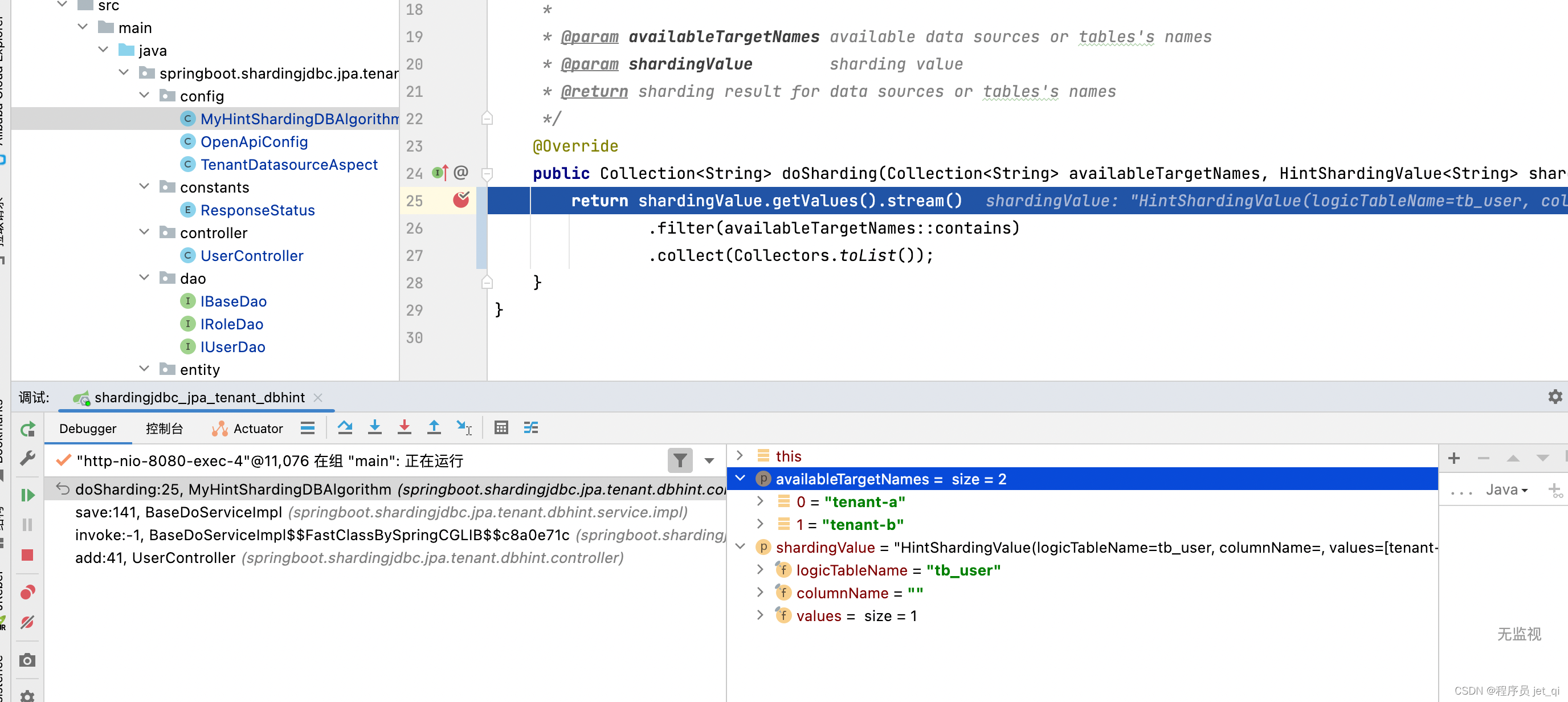
成功插入数据(因为我们上面hintManager中是tenant-a)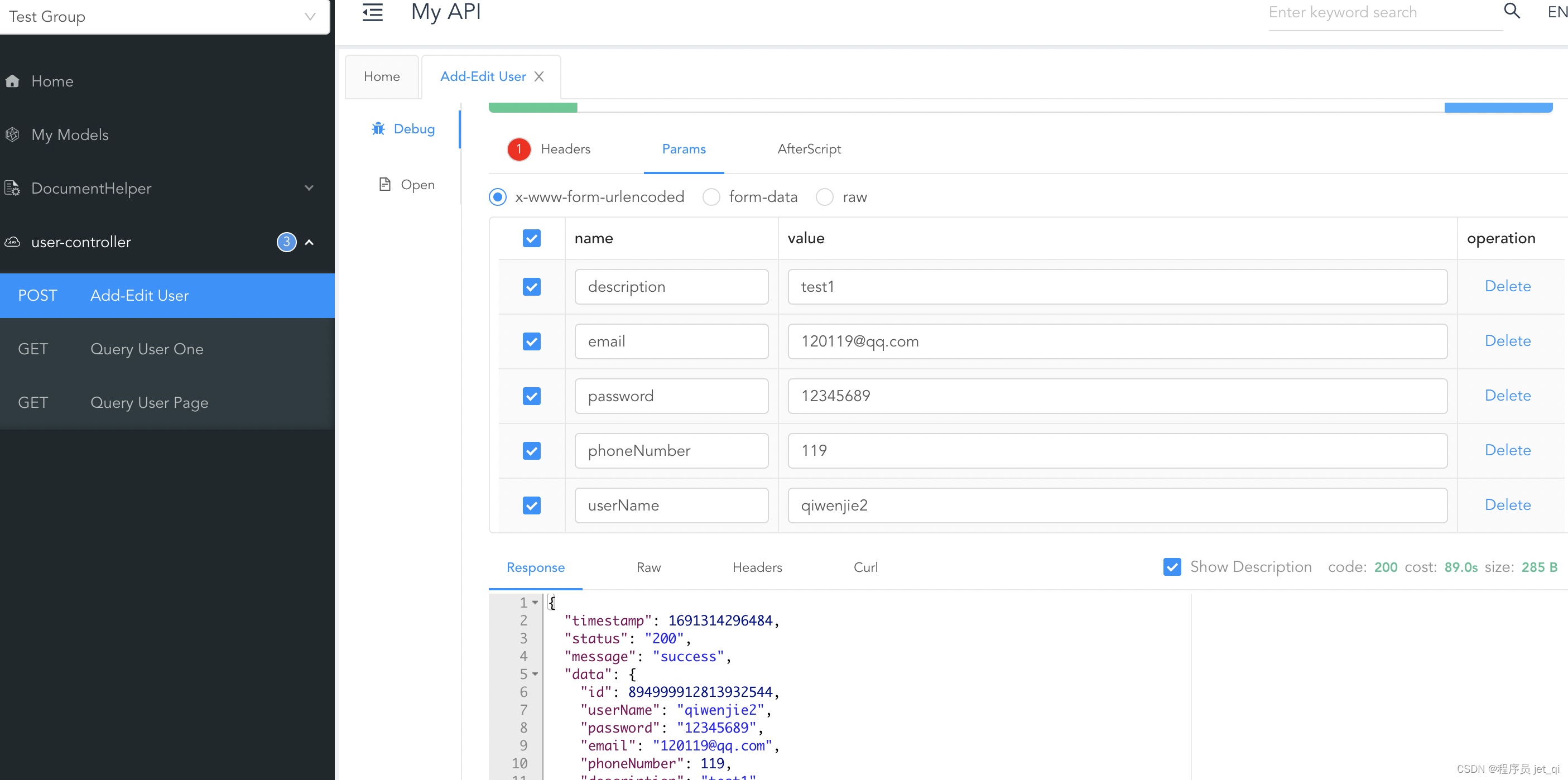
DB 中对应schema中的数据

查询数据
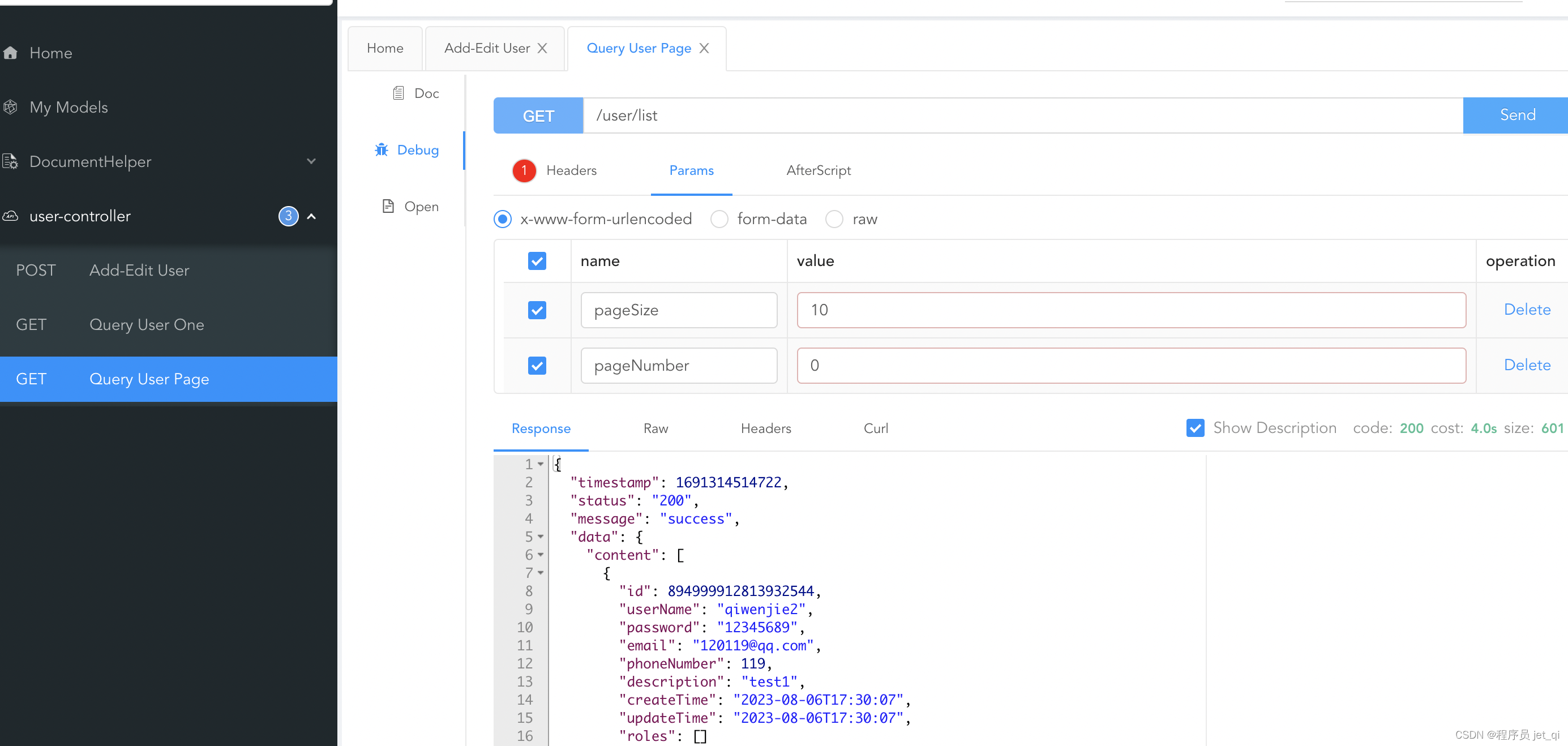
执行console log
2023-08-06 17:31:32.185 INFO 11318 --- [nio-8080-exec-4] ShardingSphere-SQL : Logic SQL: insert into tb_user (create_time, description, email, password, phone_number, update_time, user_name) values (?, ?, ?, ?, ?, ?, ?)
2023-08-06 17:31:32.186 INFO 11318 --- [nio-8080-exec-4] ShardingSphere-SQL : SQLStatement: InsertStatementContext(super=CommonSQLStatementContext(sqlStatement=org.apache.shardingsphere.sql.parser.sql.statement.dml.InsertStatement@18bd2a93, tablesContext=org.apache.shardingsphere.sql.parser.binder.segment.table.TablesContext@6879a3eb), tablesContext=org.apache.shardingsphere.sql.parser.binder.segment.table.TablesContext@6879a3eb, columnNames=[create_time, description, email, password, phone_number, update_time, user_name], insertValueContexts=[InsertValueContext(parametersCount=7, valueExpressions=[ParameterMarkerExpressionSegment(startIndex=110, stopIndex=110, parameterMarkerIndex=0), ParameterMarkerExpressionSegment(startIndex=113, stopIndex=113, parameterMarkerIndex=1), ParameterMarkerExpressionSegment(startIndex=116, stopIndex=116, parameterMarkerIndex=2), ParameterMarkerExpressionSegment(startIndex=119, stopIndex=119, parameterMarkerIndex=3), ParameterMarkerExpressionSegment(startIndex=122, stopIndex=122, parameterMarkerIndex=4), ParameterMarkerExpressionSegment(startIndex=125, stopIndex=125, parameterMarkerIndex=5), ParameterMarkerExpressionSegment(startIndex=128, stopIndex=128, parameterMarkerIndex=6), DerivedParameterMarkerExpressionSegment(super=ParameterMarkerExpressionSegment(startIndex=0, stopIndex=0, parameterMarkerIndex=7))], parameters=[2023-08-06 17:30:06.958695, test1, 120119@qq.com, 12345689, 119, 2023-08-06 17:30:06.95875, qiwenjie2])], generatedKeyContext=Optional[GeneratedKeyContext(columnName=id, generated=true, generatedValues=[894999912813932544])])
2023-08-06 17:31:32.186 INFO 11318 --- [nio-8080-exec-4] ShardingSphere-SQL : Actual SQL: tenant-a ::: insert into tb_user (create_time, description, email, password, phone_number, update_time, user_name, id) values (?, ?, ?, ?, ?, ?, ?, ?) ::: [2023-08-06 17:30:06.958695, test1, 120119@qq.com, 12345689, 119, 2023-08-06 17:30:06.95875, qiwenjie2, 894999912813932544]
2023-08-06 17:31:36.433 INFO 11318 --- [nio-8080-exec-4] ShardingSphere-SQL : Logic SQL: select user0_.id as id1_1_0_, user0_.create_time as create_t2_1_0_, user0_.description as descript3_1_0_, user0_.email as email4_1_0_, user0_.password as password5_1_0_, user0_.phone_number as phone_nu6_1_0_, user0_.update_time as update_t7_1_0_, user0_.user_name as user_nam8_1_0_, roles1_.user_id as user_id1_2_1_, role2_.id as role_id2_2_1_, role2_.id as id1_0_2_, role2_.create_time as create_t2_0_2_, role2_.description as descript3_0_2_, role2_.name as name4_0_2_, role2_.role_key as role_key5_0_2_, role2_.update_time as update_t6_0_2_ from tb_user user0_ left outer join tb_user_role roles1_ on user0_.id=roles1_.user_id left outer join tb_role role2_ on roles1_.role_id=role2_.id where user0_.id=?
2023-08-06 17:31:36.433 INFO 11318 --- [nio-8080-exec-4] ShardingSphere-SQL : SQLStatement: SelectStatementContext(super=CommonSQLStatementContext(sqlStatement=org.apache.shardingsphere.sql.parser.sql.statement.dml.SelectStatement@199ccb23, tablesContext=org.apache.shardingsphere.sql.parser.binder.segment.table.TablesContext@3335b5b4), tablesContext=org.apache.shardingsphere.sql.parser.binder.segment.table.TablesContext@3335b5b4, projectionsContext=ProjectionsContext(startIndex=7, stopIndex=541, distinctRow=false, projections=[ColumnProjection(owner=user0_, name=id, alias=Optional[id1_1_0_]), ColumnProjection(owner=user0_, name=create_time, alias=Optional[create_t2_1_0_]), ColumnProjection(owner=user0_, name=description, alias=Optional[descript3_1_0_]), ColumnProjection(owner=user0_, name=email, alias=Optional[email4_1_0_]), ColumnProjection(owner=user0_, name=password, alias=Optional[password5_1_0_]), ColumnProjection(owner=user0_, name=phone_number, alias=Optional[phone_nu6_1_0_]), ColumnProjection(owner=user0_, name=update_time, alias=Optional[update_t7_1_0_]), ColumnProjection(owner=user0_, name=user_name, alias=Optional[user_nam8_1_0_]), ColumnProjection(owner=roles1_, name=user_id, alias=Optional[user_id1_2_1_]), ColumnProjection(owner=role2_, name=id, alias=Optional[role_id2_2_1_]), ColumnProjection(owner=role2_, name=id, alias=Optional[id1_0_2_]), ColumnProjection(owner=role2_, name=create_time, alias=Optional[create_t2_0_2_]), ColumnProjection(owner=role2_, name=description, alias=Optional[descript3_0_2_]), ColumnProjection(owner=role2_, name=name, alias=Optional[name4_0_2_]), ColumnProjection(owner=role2_, name=role_key, alias=Optional[role_key5_0_2_]), ColumnProjection(owner=role2_, name=update_time, alias=Optional[update_t6_0_2_])]), groupByContext=org.apache.shardingsphere.sql.parser.binder.segment.select.groupby.GroupByContext@1b62c4af, orderByContext=org.apache.shardingsphere.sql.parser.binder.segment.select.orderby.OrderByContext@6e18abe2, paginationContext=org.apache.shardingsphere.sql.parser.binder.segment.select.pagination.PaginationContext@11a2b0d1, containsSubquery=false)
2023-08-06 17:31:36.434 INFO 11318 --- [nio-8080-exec-4] ShardingSphere-SQL : Actual SQL: tenant-a ::: select user0_.id as id1_1_0_, user0_.create_time as create_t2_1_0_, user0_.description as descript3_1_0_, user0_.email as email4_1_0_, user0_.password as password5_1_0_, user0_.phone_number as phone_nu6_1_0_, user0_.update_time as update_t7_1_0_, user0_.user_name as user_nam8_1_0_, roles1_.user_id as user_id1_2_1_, role2_.id as role_id2_2_1_, role2_.id as id1_0_2_, role2_.create_time as create_t2_0_2_, role2_.description as descript3_0_2_, role2_.name as name4_0_2_, role2_.role_key as role_key5_0_2_, role2_.update_time as update_t6_0_2_ from tb_user user0_ left outer join tb_user_role roles1_ on user0_.id=roles1_.user_id left outer join tb_role role2_ on roles1_.role_id=role2_.id where user0_.id=? ::: [894999912813932544]
2023-08-06 17:35:13.043 INFO 11318 --- [nio-8080-exec-6] ShardingSphere-SQL : Logic SQL: select user0_.id as id1_1_, user0_.create_time as create_t2_1_, user0_.description as descript3_1_, user0_.email as email4_1_, user0_.password as password5_1_, user0_.phone_number as phone_nu6_1_, user0_.update_time as update_t7_1_, user0_.user_name as user_nam8_1_ from tb_user user0_ where 1=1 limit ?
2023-08-06 17:35:13.044 INFO 11318 --- [nio-8080-exec-6] ShardingSphere-SQL : SQLStatement: SelectStatementContext(super=CommonSQLStatementContext(sqlStatement=org.apache.shardingsphere.sql.parser.sql.statement.dml.SelectStatement@590000be, tablesContext=org.apache.shardingsphere.sql.parser.binder.segment.table.TablesContext@1e7efe2a), tablesContext=org.apache.shardingsphere.sql.parser.binder.segment.table.TablesContext@1e7efe2a, projectionsContext=ProjectionsContext(startIndex=7, stopIndex=264, distinctRow=false, projections=[ColumnProjection(owner=user0_, name=id, alias=Optional[id1_1_]), ColumnProjection(owner=user0_, name=create_time, alias=Optional[create_t2_1_]), ColumnProjection(owner=user0_, name=description, alias=Optional[descript3_1_]), ColumnProjection(owner=user0_, name=email, alias=Optional[email4_1_]), ColumnProjection(owner=user0_, name=password, alias=Optional[password5_1_]), ColumnProjection(owner=user0_, name=phone_number, alias=Optional[phone_nu6_1_]), ColumnProjection(owner=user0_, name=update_time, alias=Optional[update_t7_1_]), ColumnProjection(owner=user0_, name=user_name, alias=Optional[user_nam8_1_])]), groupByContext=org.apache.shardingsphere.sql.parser.binder.segment.select.groupby.GroupByContext@d9e40b3, orderByContext=org.apache.shardingsphere.sql.parser.binder.segment.select.orderby.OrderByContext@102ea4bd, paginationContext=org.apache.shardingsphere.sql.parser.binder.segment.select.pagination.PaginationContext@497243f6, containsSubquery=false)
2023-08-06 17:35:13.044 INFO 11318 --- [nio-8080-exec-6] ShardingSphere-SQL : Actual SQL: tenant-a ::: select user0_.id as id1_1_, user0_.create_time as create_t2_1_, user0_.description as descript3_1_, user0_.email as email4_1_, user0_.password as password5_1_, user0_.phone_number as phone_nu6_1_, user0_.update_time as update_t7_1_, user0_.user_name as user_nam8_1_ from tb_user user0_ where 1=1 limit ? ::: [10]
2023-08-06 17:35:14.695 INFO 11318 --- [nio-8080-exec-6] ShardingSphere-SQL : Logic SQL: select roles0_.user_id as user_id1_2_0_, roles0_.role_id as role_id2_2_0_, role1_.id as id1_0_1_, role1_.create_time as create_t2_0_1_, role1_.description as descript3_0_1_, role1_.name as name4_0_1_, role1_.role_key as role_key5_0_1_, role1_.update_time as update_t6_0_1_ from tb_user_role roles0_ inner join tb_role role1_ on roles0_.role_id=role1_.id where roles0_.user_id=?
2023-08-06 17:35:14.696 INFO 11318 --- [nio-8080-exec-6] ShardingSphere-SQL : SQLStatement: SelectStatementContext(super=CommonSQLStatementContext(sqlStatement=org.apache.shardingsphere.sql.parser.sql.statement.dml.SelectStatement@5071f907, tablesContext=org.apache.shardingsphere.sql.parser.binder.segment.table.TablesContext@b58932f), tablesContext=org.apache.shardingsphere.sql.parser.binder.segment.table.TablesContext@b58932f, projectionsContext=ProjectionsContext(startIndex=7, stopIndex=271, distinctRow=false, projections=[ColumnProjection(owner=roles0_, name=user_id, alias=Optional[user_id1_2_0_]), ColumnProjection(owner=roles0_, name=role_id, alias=Optional[role_id2_2_0_]), ColumnProjection(owner=role1_, name=id, alias=Optional[id1_0_1_]), ColumnProjection(owner=role1_, name=create_time, alias=Optional[create_t2_0_1_]), ColumnProjection(owner=role1_, name=description, alias=Optional[descript3_0_1_]), ColumnProjection(owner=role1_, name=name, alias=Optional[name4_0_1_]), ColumnProjection(owner=role1_, name=role_key, alias=Optional[role_key5_0_1_]), ColumnProjection(owner=role1_, name=update_time, alias=Optional[update_t6_0_1_])]), groupByContext=org.apache.shardingsphere.sql.parser.binder.segment.select.groupby.GroupByContext@6b467890, orderByContext=org.apache.shardingsphere.sql.parser.binder.segment.select.orderby.OrderByContext@f0ab398, paginationContext=org.apache.shardingsphere.sql.parser.binder.segment.select.pagination.PaginationContext@506ccabf, containsSubquery=false)
2023-08-06 17:35:14.696 INFO 11318 --- [nio-8080-exec-6] ShardingSphere-SQL : Actual SQL: tenant-a ::: select roles0_.user_id as user_id1_2_0_, roles0_.role_id as role_id2_2_0_, role1_.id as id1_0_1_, role1_.create_time as create_t2_0_1_, role1_.description as descript3_0_1_, role1_.name as name4_0_1_, role1_.role_key as role_key5_0_1_, role1_.update_time as update_t6_0_1_ from tb_user_role roles0_ inner join tb_role role1_ on roles0_.role_id=role1_.id where roles0_.user_id=? ::: [894999912813932544]
4、示例源码
Todo
5、商品中心对ShardingJdbc的使用
Todo
6、白龙马对ShardingJdbc的使用
Todo

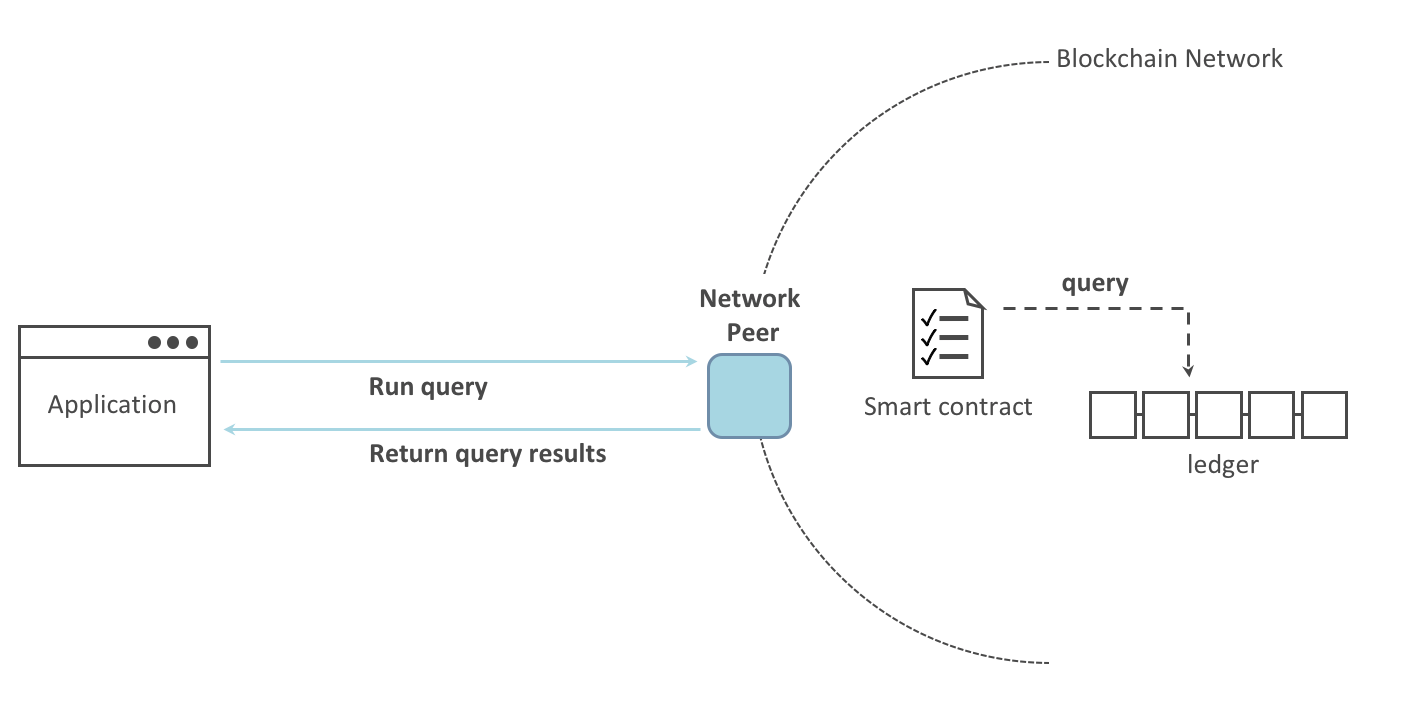
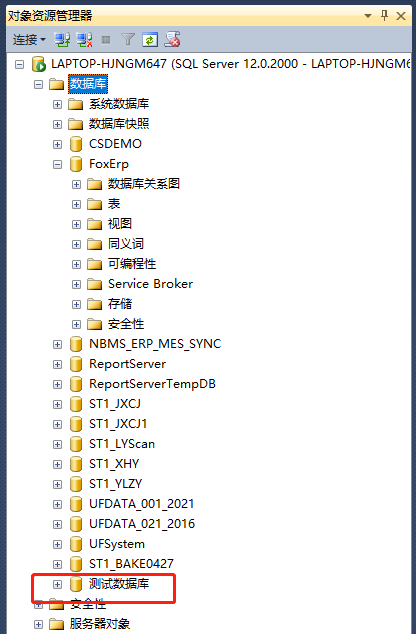
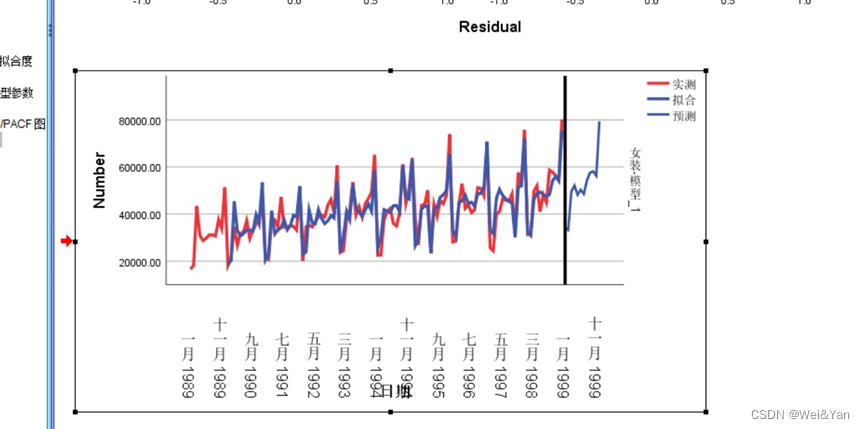
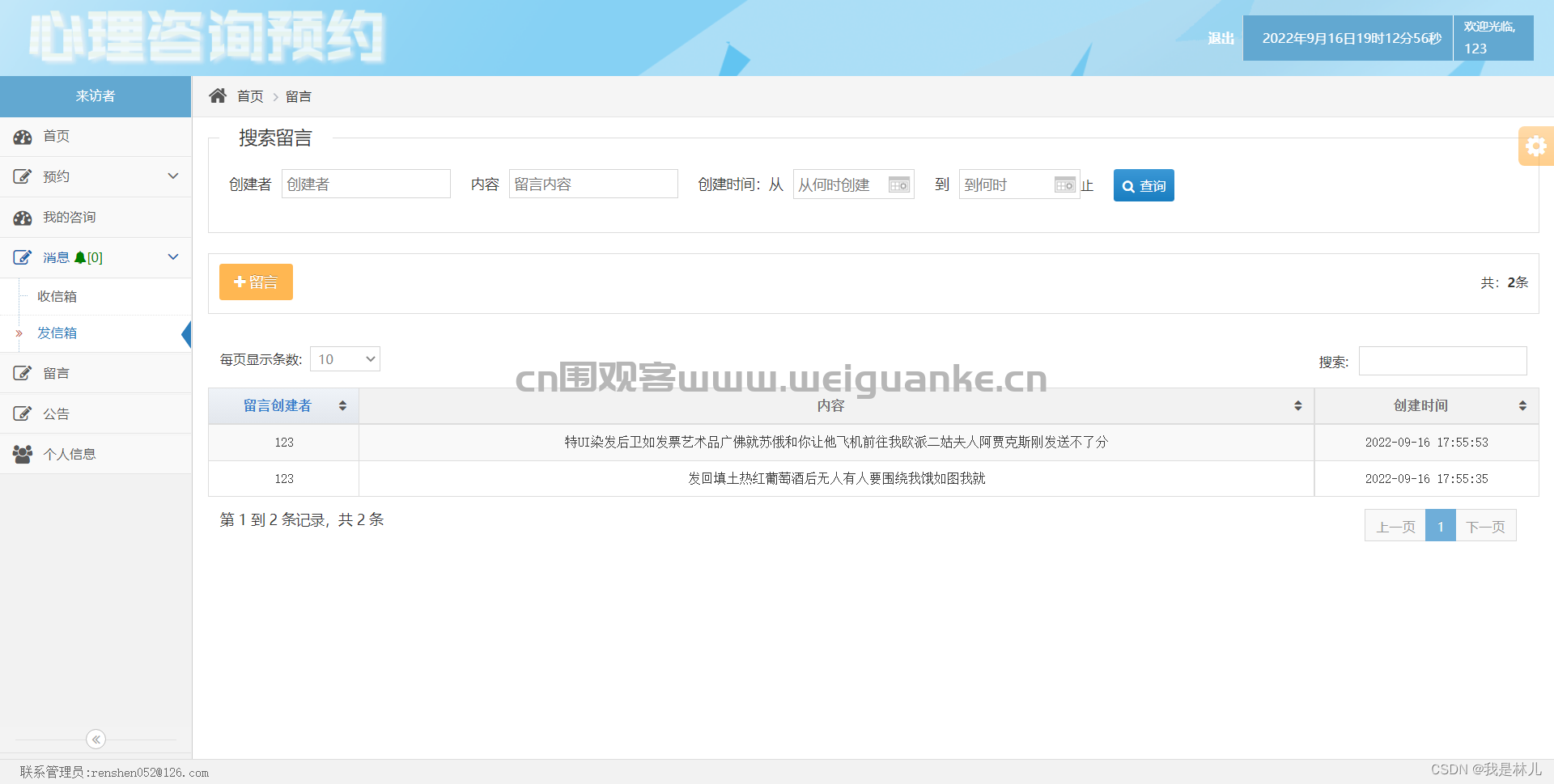

![[LeetCode - Python] 11.乘最多水的容器(Medium);26. 删除有序数组中的重复项(Easy)](https://img-blog.csdnimg.cn/d8583aed89c74b628cfa1e67253e2e79.png)

